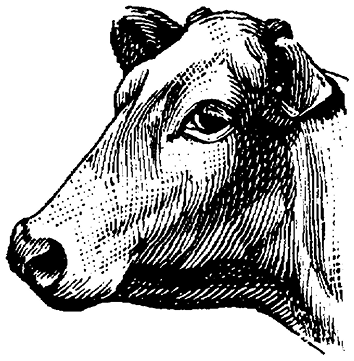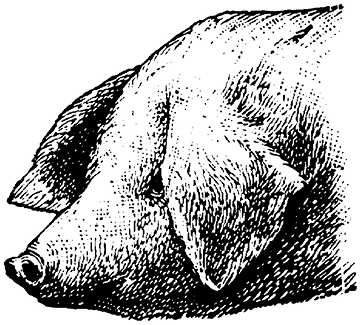4-H Livestock Judging Manual
Contents
- Introduction
- Why Judge Livestock?
- Breeds of Livestock
- Livestock Judging
- Basics
- Placing Card
- Class of Livestock
- Livestock Judging Contest
- How to Begin
- Developing a Judging System
- Oral Reasons
- How Good Are Your Oral Reasons?
- Rules for Giving Oral Reasons
- Importance of Accuracy
- Organization of a Set of Reasons
- Sample Notes
- Reasons Format
- Transitions
- Sample Set of Reasons
- Delivering a Set of Oral Reasons
- Terminology for Oral Reasons
- Beef Cattle
- Breeds of Beef Cattle
- Parts of Beef Cattle
- Handling Market Steers
- Beef Cattle Terminology
- Performance Data for Beef Cattle
- Production Situations for Beef Cattle
- Sample Oral Reasons for Beef Cattle
- Junior Yearling Brangus Heifers
- Limousin Heifers
- Market Steers
- Performance Limousin Bulls
- Sheep
- Breeds of Sheep
- Parts of Sheep
- Handling Market Lambs
- Sheep Terminology
- Performance Data for Sheep
- Production Situations for Sheep
- Sample Oral Reasons for Sheep
- Dorset Ewes
- Market Lambs
- Swine
- Breeds of Swine
- Parts of Swine
- Swine Terminology
- Performance Data for Swine
- Production Situations for Swine
- Sample Oral Reasons for Swine
- Market Hogs
- Hampshire Gilts
- Glossary
Introduction
Livestock judging is a process of evaluating, selecting, placing, and learning the various livestock species–beef cattle, sheep, and swine. Judging is the foundation of any 4-H livestock project. Feeding, exercising, grooming, and showing the animal are all important aspects of your 4-H project; however, none may be as exciting as selecting your project animal. Selection of project animals is actually judging livestock, comparing the merits of one animal against the merits of other potential project animals. This selection process is just one of many applications of livestock evaluation and judging.
Livestock producers, breeders, feeders, buyers, and packers evaluate livestock for their potential as either breeding or market animals. These people try to relate the “form” of an animal with the “function” for which it is intended to serve. That is why livestock judging is often called the application of “form and function” to livestock.
Why Judge Livestock?
Stockpersons judge livestock to differentiate between superior, average, and inferior animals within each of the livestock industries. They are looking for the most desirable animals for their particular needs. Stockpersons often compare their own livestock to those of others. Using their judging knowledge and skills, producers analyze the potential value of animals for particular purposes.
As a result of reading this manual; listening to your parents, 4-H leaders, and county Extension agents; and practicing on your own, you should be able to do the following:
- Identify the different breeds of livestock
- Compare livestock for their merit and value as either breeding or market animals
- Look at an animal and determine desirable characteristics and faults
- Improve your livestock project by selecting more desirable animals and gain an appreciation of their value for a particular purpose
- Make decisions and defend them in a logical, well-organized manner
- Make complex decisions based on available information
- Develop confidence
- Develop oral communication skills
- Appreciate the opinions of others
Breeds of Livestock
Before learning to compare animals of the same breed, you need knowledge of the most popular breeds. This manual outlines distinguishing characteristics of the major breeds within each species: beef cattle, hogs, and lambs. Use the pictures under each species as a reference.
Livestock Judging
Basics
After learning why livestock are judged, you can begin to appreciate why it takes considerable practice to become a good judge of livestock. In this section, the placing card, a class of livestock, and the livestock judging contest will be discussed.
Placing Card
The placing card is the official record of how a person placed a class. Every time you judge a class of livestock, you will be given a placing card. The type of placing cards used in Mississippi contests is shown in Figure 1 (below). Other contests may use similar placing cards. In contest block A, indicate which division you are competing in (most likely, Junior or Senior). Block B is for your team number and contestant number (example 1-A). Block C is for the class name and the class number. Put the name of the class in this block (for example, Angus Heifers). The blocks for D and E are for offical use only and should remain blank. Finally, draw a circle around your desired placing in the bottom section of the card.
In the example, a Junior contestant (1-A) placed Class 4, Angus Heifers, 3-1-4-2. This placing indicates the most desirable animal is number 3 and the least desirable animal is number 2.
Be sure each card you turn in has your contestant number and that you have indicated the name of the class. Circle only one placing on your judging card, and check your placing before turning in your card.
Class of Livestock
A class in a livestock judging contest consists of four animals of one particular breed, sex, and age group, such as Suffolk Yearling Ewes, Dorset Ram Lambs, Crossbred Market Hogs, Duroc Boars, Summer Yearling Hereford Bulls, and Brangus Heifer Calves. The animals will be numbered 1, 2, 3, and 4 so they can be readily identified. Numbers will probably be on the backs or arms of the people holding the animals. A possible exception to this system is when judging beef cattle or sheep and the animals are haltered or are being held in racks. When this is the case, number the animals from left to right as you stand behind them.
Livestock Judging Contest
A livestock judging contest includes classes of beef cattle, sheep, and swine. You may judge either market or breeding classes or both. If you place the class correctly, you will receive a score of 50 points for the placing. If you incorrectly place one or two pairs, or if you make other placing errors, your score will be determined by the seriousness of the error.
In many judging events, you will have the opportunity to give oral reasons. Oral reasons allow you to justify your placings to an official judge. The official judge will score you on accuracy, completeness, length, presentation and delivery, and terminology. A score of 50 points is the highest awarded for oral reasons. Detailed information on reasons can be found in the following “Reasons” section of this manual.
A livestock judging contest is simply a collection of various classes of livestock. There can be as many classes in a contest as the officials desire; usually, there are at least two classes.
Always follow the instructions of your group leader or the person in charge of the contest. If you have any questions, ask your group leader and not another contestant. No talking between contestants is allowed during the contest.
As you approach a class of livestock, you will probably be told to turn your back toward the class and to label your placing card. Do not begin judging until told to do so!
Once “time is in,” begin judging. You will have from 10 to 15 minutes to place a class, with most classes being 15 minutes. With approximately 2 or 3 minutes remaining in a class, you will be asked to mark your card. Make certain that your contestant number, class name and number, and placing are on the card. When “time is out,” turn your back toward the class, check your placing one last time, and hand your placing card to your group leader.
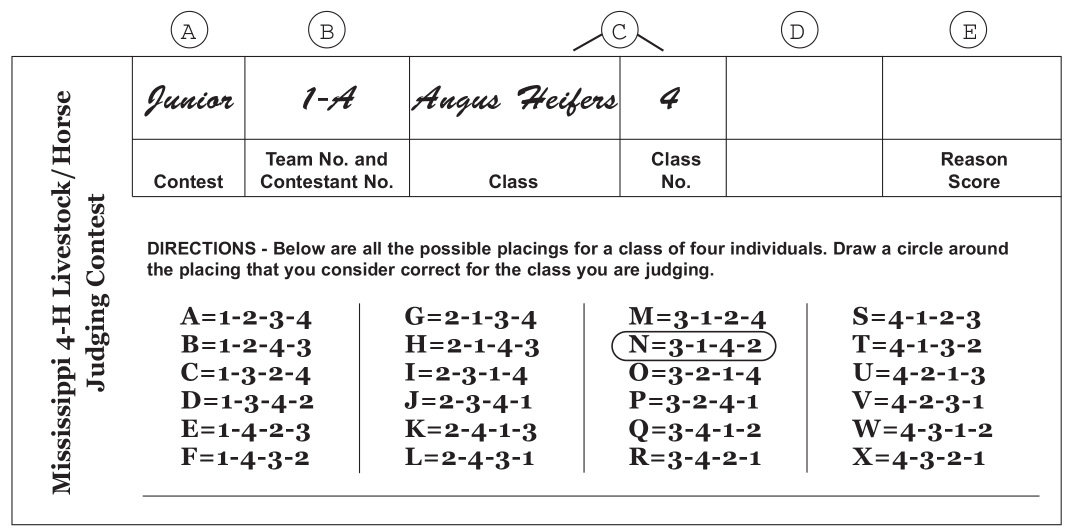
How to Begin
Before you start judging livestock, try to make a mental image of the perfect animal. Do this by recalling the most desirable features of the high-quality animals that you have seen and by thinking of them as belonging to one animal. You can also study pictures of champions, show reports, current livestock magazines, or ideal-type pictures from the breed associations.
In the contest system, four animals are typically in each class. As you judge, divide the class into three pairs: a top pair, a middle pair, and a bottom pair. Make comparisons between these pairs. As you look at any class, have five animals in mind: the four in the class and the ideal animal of that breed, sex, and age group.
Developing a Judging System
Each time you judge a class of livestock or analyze a group of livestock, rely on a system of observing the animals.
Following are a few pointers for judging a class of livestock:
- Stand Back – Allow enough room between yourself and the animals so you can see all four animals at once. Usually, 25 to 30 feet is a good distance from which to view the class. Become skilled in placing the classes from a distance, and handle the animals only to confirm your observations. It is a mistake to place a class only with your hands. An exception is market lambs, which are often placed on visual appraisal as well as on handling.
- Three Angles – Try to look at the class from the side, front, and rear views. Compare each animal to the others in the class and to the “ideal” animal that you have pictured in your mind.
- Big Things First – Always look for and analyze the good and bad characteristics of each animal in the major areas such as frame size, volume, condition, muscling, balance, structural correctness, movement, and breed character. Learn to study the animals carefully. Concentrate on the parts of the animal that yield the high-priced cuts. A keen judge of livestock is orderly and is never haphazard. Make your placings according to the big things, unless a pair of animals are very similar, causing you to analyze the minor differences between the animals.
- Place the Class – Once you have analyzed the important factors that go into placing a class, place the class. Mark your placing at the top of your notebook or reasons card, and begin taking notes. A more thorough discussion of note taking and reasons format is in the “Oral Reasons” section of this manual.
- Close Inspection – Usually, you will be given some time for close inspection of a class. When you are near the animals for close inspection or handling, simply confirm the decisions you made at a distance. If an animal appears different (or handles differently) from what it looked like from a distance and if the difference merits consideration, then change your placing. Close inspection is different for each species, so they will be dealt with separately.
Beef Cattle – During close inspection of beef cattle, you probably will not be permitted to handle breeding animals, but you may be allowed to handle animals in a market class. If you are permitted to handle the animals, move quietly and cautiously so you don’t excite or frighten the animals (See “Handling Market Steers”).
Sheep – During close inspection of sheep, you may or may not be permitted to handle breeding and market classes. Again, move quietly and cautiously so the animals do not become nervous or excited. A section in this manual deals with the preferred method of handling sheep (See “Handling Market Lambs”).
Swine – There are no predetermined guidelines for close inspection of swine because hogs are usually judged loose in a pen. At any time during the class, you may kneel and look at underlines, ear notches, or feet and legs. Make this part of your normal routine for judging pigs.
Stand Back and Take Notes – Even if it is not a reasons or questions class, write down a few notes on why you placed the class the way you did. If it is a reasons class or a class with questions, stand back from the class and write your notes for reasons. If you are unsure of something, either try to look at it again or omit it. If you are unsure and guess, you will probably be wrong. Try to be accurate and descriptive when writing notes, and remember what the animals look like.
Oral Reasons
Good judges of livestock have a special quality that an average judge does not possess. A good judge can accurately and concisely describe an animal or group of animals so that an audience knows exactly what the judge saw. The ability to describe animals accurately and concisely is the basic foundation of the reasons process. This section is devoted to reasons, starting with the basics and ending with a lengthy list of terminology.
- Giving reasons will help you do the following:
- Develop a system for analyzing a class of livestock
- Think more clearly on your feet
- Organize and state your thoughts more clearly
- Improve your speaking poise and presentation
- Improve your voice
- Develop your memory
You should know the parts of the various livestock species and how they join to make a particular breeding or market animal. Every animal is different and so is every class of livestock. Therefore, there are no guidelines or rules for placing a class. Nor is there a right way or a wrong way to deliver or present a set of reasons.
How Good Are Your Oral Reasons?
The judge will determine the value of your reasons by the following:
- Accuracy – You must tell the truth. You must see the important things in the class correctly. Accuracy is very important. You will lose points for incorrect statements.
- Completeness – Describe all the major differences in your reasons. Omit small things that leave room for doubt.
- Length – A well-organized, properly delivered set of reasons must never be more than 2 minutes in length.
- Presentation and Delivery – Present your reasons in a logical manner that is pleasant to hear, is clear, and is easy to follow. If reasons are poorly presented, the value of accuracy may be lost because most of what you say doesn’t “get through” to the listener. Speak slowly and clearly in a conversational tone. Speak loudly enough to be understood, but avoid talking too loudly or too rapidly. Use well-organized statements and use correct grammar. Emphasize the important comparisons and be confident in your presentation.
- Terminology – Use correct terminology. Incorrect terminology greatly detracts from the value of your reasons. Study and use the terms in this guide (See “Terminology for Oral Reasons”).
Rules for Giving Oral Reasons
- Do not claim strong points for one animal unless the animal has them. Claim the points when one is superior, and then grant to the other animal its points of advantage.
- Strongly emphasize major differences. Present the important differences first on each pair.
- Be concise and definite. Don’t search for things to say. If you don’t remember, go on to the next pair you are to discuss.
- State your reasons with confidence and without hesitation. Talk with enough vim and vigor to keep the judge interested, but do not yell or shout.
- End reasons strongly. Give a concise and final statement on why you placed the fourth-placed animal last.
- Be sure you have your reasons well organized so you do not hesitate when you present them to the judge.
The most important factors that go into an effective set of reasons include the following:
- Accuracy
- Organization
- Delivery
- Terminology
Let’s review these factors to improve your set of reasons.
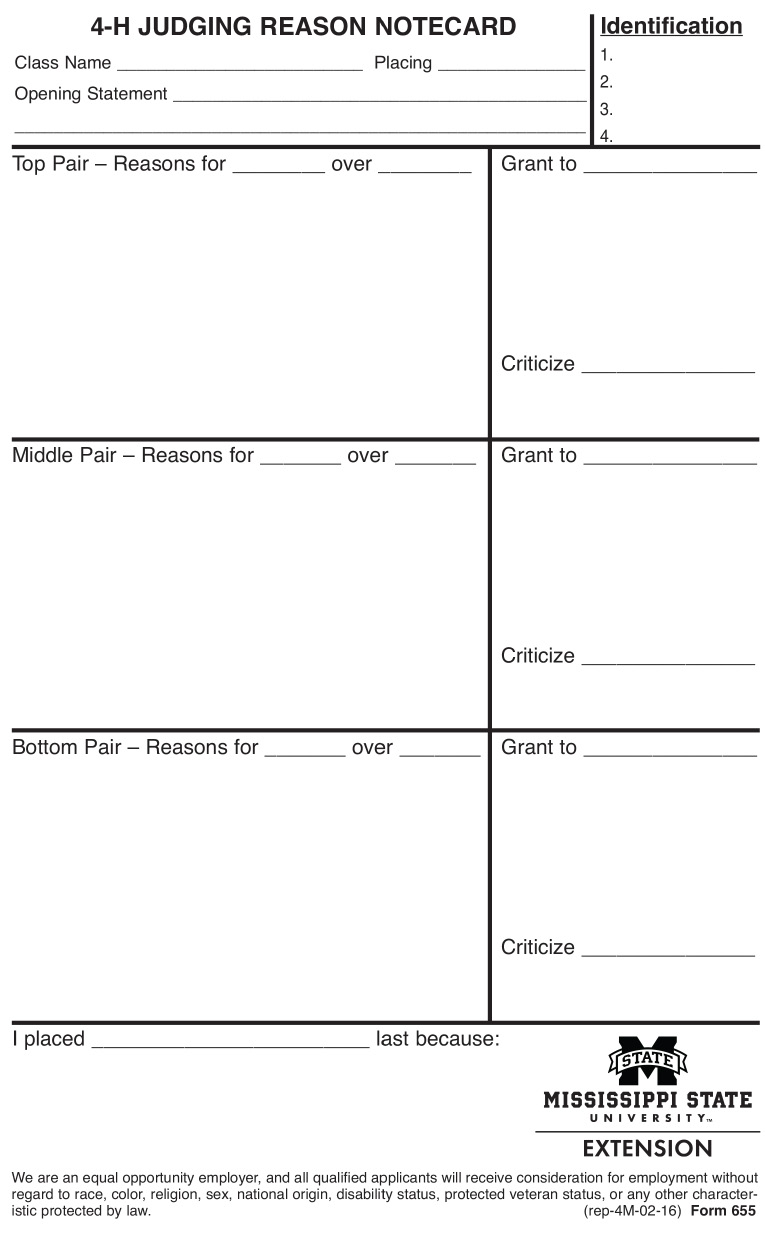
Importance of Accuracy
Accuracy is the most important aspect of a good set of reasons. Not only must you be able to see important differences among animals, but you must be able to describe these differences accurately. Two animals may be extremely similar except for one or two minor differences, or they may be extremely different and have very little in common. In your reasons, you must be able to identify the important differences and similarities among animals and convey these traits to the judge. The official judge will want you to paint a picture of the animals by using the proper terminology to describe the animals.
Correct phrases about the livestock are the foundation of accuracy. Claim strong points for an animal only if the animal has them. Do not try to make small differences into big placing points. Furthermore, do not try to impress the judge with a discussion of every point that is different among animals. Discuss only the most important reasons for placing one animal above another.
Organization of a Set of Reasons
Organization is the second important factor that should be a part of your reasons. It is easier for the person listening to you to understand what you are saying if you present things in a logical, well-ordered fashion. This organization begins with taking notes. If your notes are organized, your reasons will be organized also.
In your reasons, divide a class into three pairs: a top pair, a middle pair, and a bottom pair. Your notes for reasons also should be divided into three pairs.
When taking notes, use either the 4-H Judging Reasons Notecard or a notebook, both of which will be described in this section.
You may use the Reasons Notecard or a notebook in the same manner as shown in Figures 2 and 3. However, the notecard may be easier for beginners and juniors. Line A is used for class name and Line B is for class placing. Section C refers to the opening statement for the class. Boxes D, E, and F refer to the top pair; boxes G, H, and I refer to the middle pair; and J, K, and L refer to the bottom pair. Boxes D, G, and J are for placings; boxes E, H, and K are for grants; and boxes F, I, and L are for faults or criticisms. This outline for note taking can be used for any class of four animals with any placing.
Sample Notes
When you begin taking notes, always write down the most obvious characteristics first, then underneath the big things, write the details or specific differences.

Reasons Format
The format used for reasons is simple and straightforward and allows for a complete description of a class. This style does require an understanding of livestock evaluation as animals are analyzed in great detail, and one must have the ability to recognize important differences and to place these differences in a priority order.
Following is an outline that demonstrates the basic format:
Opening statement: Selecting the most . . ., I chose the alignment of 1-2-3-4 for the (name of class).
Criticism of top animal: I realize that 1 could be . . . .
Comparison of 1 over 2: Nevertheless, I used 1 over 2 in the top pair as he was . . . .
Grants 2 over 1: Sure, 2 was . . . .
Criticism of 2: but, the Duroc barrow is . . ., so he is second.
Comparison of 2 over 3: However, with these faults aside, it is the . . . of 2 over the . . . of 3.
Grants 3 over 2: I recognize that 3 is . . . .
Criticism of 3: but at the same time, he is . . . .
Comparison of 3 over 4: Even so, in my concluding pair, 3 beats 4. He is a more . . . .
Grant 4 over 3: I realize 4 is . . . .
Criticism of 4: However, this does not make up for the fact . . . .
The type of terminology used in each section of the reasons is important. In the opening statement on the top animal, you may use either descriptive terms or class comparisons. In the pair comparisons, you may use either class comparisons (. . .est) or simple comparative (. . .er) terms. Grants are comparative terms or class comparisons. Criticisms are descriptive (no “er” terms) or class comparisons.
Properly used, this format will allow you to completely describe all of the important points in a class in a well-organized, easy-to-follow manner.
Transitions
Transitions are a way of moving smoothly from one section of the reasons to another. This is done as simply as possible while still maintaining a smooth transition. We strongly discourage excessively wordy transition statements.
Listed below are words to use when moving into a grant:
- Grant
- Recognize
- Realize
- Concede
- Admit
- Yes
You may want to try something such as this statement: “2 is straighter lined and cleaner fronted, but he is . . .” (move into criticism). Here we are using only “but” for the transition term, but effective voice inflection is necessary to make this work.
To move into a criticism, use the following language:
- I realize that 1 is . . .; nevertheless, I used him in the top pair over 2 as he was . . . .
- But he is the lightest muscled, barest handling . . . .
- But I criticized 2 and left him second, as he was . . . .
- But I faulted 2 and placed him second, as he was . . . .
When moving into another pair, here are some transitions that can be used:
- Still, in the bottom pair, I used 3 over 4.
- Nonetheless, in the top pair of heavier muscled gilts, it’s 1 over 2.
- Nevertheless, in the middle pair, I used 2 over 3.
- Even so, in the bottom pair . . . .
- However, in the middle pair . . . .
Just a brief word about originality: Experiment with different transitions and phrasings. Try them on the coach, and if he or she doesn’t like them, you will be the first to know. Note to the juniors: Get the basics down first, then start finding original ways to say things.
Sample Set of Reasons
“I placed the Angus Heifers 3-1-4-2.
I started the class with 3, the heaviest muscled, highest volumed, growthiest heifer in the class. Ideally, I would like to see her longer necked and smoother shouldered! Even so, I used 3 over 1, as she was a larger framed, heavier muscled, bigger volumed, growthier heifer. She was a longer bodied, taller topped heifer that has more arch and spring of rib, with more width and natural thickness down her top and through all portions of her quarter. In addition, she appeared to have a higher weight per day of age. However, I do admit that 1 was a more feminine-fronted heifer, being more refined about her head, longer necked, and laid in smoother about her shoulder, but she was a shallower ribbed, lighter muscled heifer that is pinched in her forerib.
Coming to my middle pair, I placed 1 over 4 because she was a more feminine, longer bodied, and more structurally correct heifer. She was especially smoother through her neck/shoulder junction, longer sided, and stood more squarely on her feet and legs. Granted, 4 was a heavier muscled, more ruggedly designed heifer that stood on more substance of bone, but I criticized her for being a more conventional, coarser shouldered heifer that was cow hocked and splay footed.
Dropping to my bottom pair, I placed 4 over 2 as she was a heavier, bigger volumed, heavier muscled heifer that stood on a greater diameter of bone. She had more arch and spring through a deeper rib, with more thickness down her top and a greater volume of muscle from hip to hock. However, 2 was a more feminine, leaner about her neck, and smoother shouldered. Nonetheless, 2 was the smallest framed, lightest muscled, narrowest made heifer in the class and stood on the finest bone with the lowest weight per day of age. Thank you.”
Delivering a Set of Oral Reasons
Delivery is the third factor that is necessary for a good set of reasons. Everyone is nervous the first time he or she gives a set of reasons, but with practice, it will become easier. These six factors for delivering a good set of reasons will help you:
- Flow – The way you put words together into phrases, sentences, and paragraphs is considered flow. A group of short, choppy phrases, each standing alone, is boring and difficult to follow. A group of long, smooth-flowing phrases is enjoyable for the listener. Begin your reasons at one speed and keep a similar pace throughout the entire set. Don’t talk too quickly or too slowly. Speaking without hesitation will allow you to receive a higher score for your reasons. The only times to pause are between pairs and when you need to take a breath. Follow every set of reasons with a sincere “Thank you.”
- Inflection – Voice inflection is one of the most important items in your delivery. Place emphasis on the words that describe the important characteristics of each animal. Careful selection of key words to emphasize will take some practice, but in time, it should become a normal part of your oral reasons.
- Volume – The volume you use to deliver your reasons will depend on how you normally speak and the size of the room. If you are soft spoken and are in a large room, increase the volume of your voice in order to be heard and understood clearly. If you are normally loud and are giving reasons in a small room, decrease the volume of your voice so it doesn’t echo.
- Eye Contact – Try to look at the person who is listening to your reasons. If you maintain eye contact throughout the entire set, your reasons will be more professional. Direct your discussion toward the official even if you do not look the judge straight in the eye. It is easier for some people to look at the top of the judge’s head when giving reasons rather than looking him or her directly in the eye. You will receive a higher score if you do not gaze into space or look around the room.
- Distance – Depending on your voice and stature, the distance you stand from the judge will vary. A short, soft-spoken person should stand closer to the judge than a tall, deep-voiced person whose voice carries well. Nonetheless, 6 to 10 feet is generally adequate.
- Stance – When giving a set of reasons, make the situation as comfortable as possible for the judge and for yourself. Stand upright, with your hands behind your back or folded at your waist. Place your feet squarely at shoulders’ width. Avoid rocking back and forth or rolling on the balls of your feet.
Terminology for Oral Reasons
Terminology is the fourth and final factor that goes into an effective set of reasons. Try to put the words and phrases together in a well-organized, logical fashion when describing livestock. Be sure to describe only what you see, and never invent things that are not there.
It is important to know the meaning of every term or phrase you use. An official who is unfamiliar with a certain term may ask you to define it further. As you look over the terms, try to picture an animal with the characteristics described by the terms, or terminology. If you are uncertain about the exact meaning of a term or phrase, ask your parents, 4-H leader, or Extension agent.
More desirable and less desirable characteristics are listed on the terminology pages for several traits of each species (beef, swine, sheep). Use caution when applying the terminology in a set of reasons; in some instances, a desirable characteristic in one situation may actually be an undesirable characteristic in another (for example, larger framed versus smaller framed). Furthermore, not every term in the lists has an appropriate opposite term; if there is no term, it is shown as ————. For terms that contain a blank (_____), insert the appropriate part of the animal you are describing.
Beef Cattle
Breeds of Beef Cattle
Table 1 outlines some breeds of beef cattle that are common in the United States. Each breed is categorized by frame size, muscling, mature cow weight, milking ability, and some of the more distinguishing features of the breed.
Frame size is divided into three categories: small, average, and large. Muscle is divided into three categories: flat, medium, and thick. Average mature cow weight is listed in pounds and describes the size of cows of this breed relative to other breeds.
It is important to remember that this table is for reference only. As much variation exists within a particular breed of livestock as among breeds for such characteristics as milking ability, muscle, and so on. Therefore, the data contained in this table represent averages, not absolute values, for particular breeds. The table is provided as a reference to help you better distinguish one breed from another.

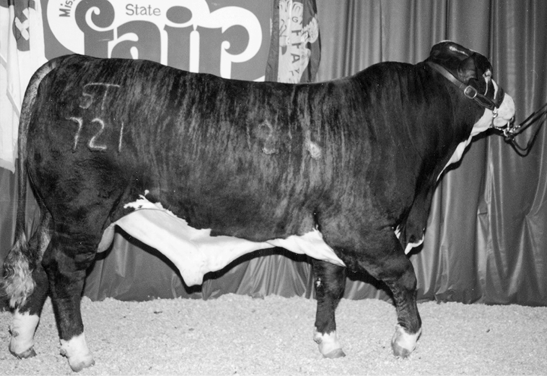
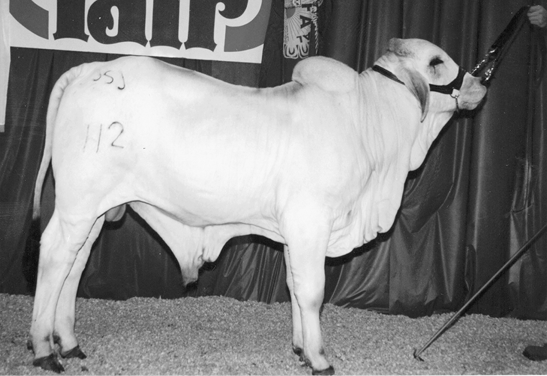
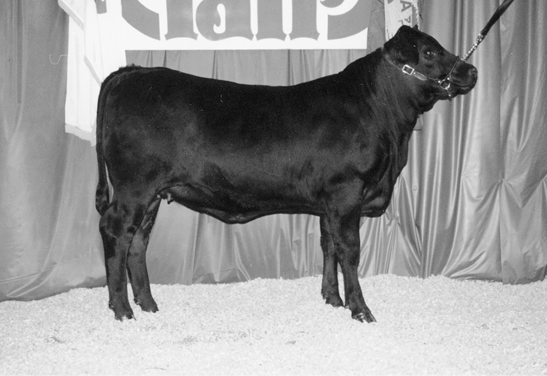
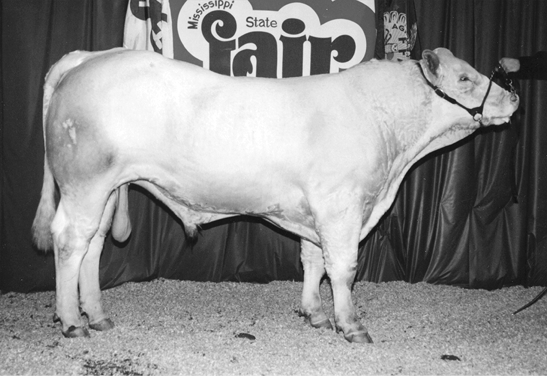


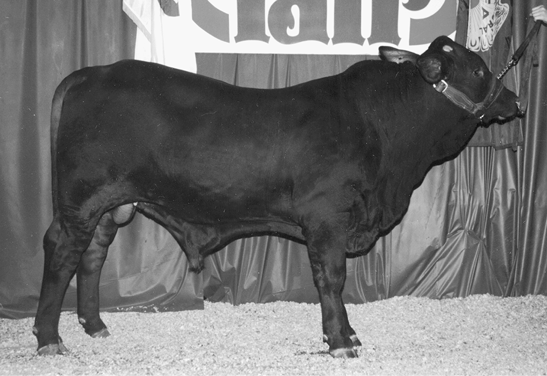



|
Breed |
Frame size |
Muscle |
Avg. cow wt. |
Birth wt.a |
Wean wt.a |
Post-wean wt.a |
Characteristics |
|---|---|---|---|---|---|---|---|
|
Angus |
avg. |
med. |
1,100 |
2 |
4 |
4 |
black; polled; pigment; fertility |
|
Beefalo |
small |
med. |
varies |
—— |
—— |
—— |
brown; 3/8 Buffalo, 5/8 Bovine |
|
Beefmaster |
avg. |
med. |
varies |
4 |
2 |
2 |
1/2 Brahman, 1/4 Hereford, 1/4 Shorthorn |
|
Blonde d’Aquitaine |
large |
thick |
1,500 |
4 |
3 |
2 |
blonde; terminal sire |
|
Braford |
avg. |
med. |
1,250 |
—— |
—— |
—— |
reddish; 3/8 Brahman, 5/8 Hereford |
|
Brahman Brangus |
avg. avg. |
med. med. |
1,400 1,250 |
4 3 |
1 3 |
3 3 |
various colors; heat tolerance; “hump” black or red; 3/8 Brahman, 5/8 Angus |
|
Charbray Charolais |
large large |
med. thick |
1,500 1,550 |
—— 5 |
—— 1 |
—— 1 |
whitish gray; 3/8 Brahman, 3/8 Charolais white; muscle; growth |
|
Chianina |
large |
med. |
1,600 |
5 |
1 |
1 |
white, silver, brindle, or black; terminal sire |
|
Devon |
small |
flat |
1,100 |
3 |
4 |
2 |
dark red; carcass quality |
|
Galloway |
small |
flat |
950 |
3 |
4 |
3 |
black; long, curly hair; late maturing |
|
Gelbvieh |
avg. |
thick |
1,450 |
4 |
1 |
2 |
pale brownish-orange; milk; growth |
|
Hereford |
avg. |
med. |
1,100 |
3 |
4 |
3 |
red with white face; adaptability; fertility |
|
Limousin |
avg. |
thick |
1,300 |
4 |
3 |
3 |
pale brown, golden; muscle; cutability |
|
Longhorn |
small |
flat |
varies |
1 |
5 |
5 |
various colors; late maturing; long, slender horns |
|
Maine-Anjou |
large |
thick |
1,600 |
5 |
1 |
1 |
deep red and white; frame; growth rate; muscle |
|
Marchigiana |
large |
thick |
1,500 |
—— |
—— |
—— |
grayish-white; muscle; terminal sire |
|
Murray Grey |
small |
med. |
1,150 |
3 |
3 |
4 |
gray; low birth weights |
|
Pinzgauer |
avg. |
thick |
1,350 |
4 |
2 |
2 |
brown with white topline, underline; hardiness |
|
Red Angus |
avg. |
med. |
1,100 |
2 |
4 |
3 |
red; polled; fertility |
|
Salers |
avg. |
med. |
1,300 |
—— |
—— |
—— |
dark red or black; low birth weight; growth |
|
Santa Gertrudis |
large |
med. |
1,450 |
4 |
2 |
3 |
deep red; 3/8 Brahman, 5/8 Shorthorn |
|
Scotch Highland |
small |
flat |
900 |
2 |
4 |
4 |
dun; long, dense, shaggy hair |
|
Shorthorn |
avg. |
med. |
1,100 |
3 |
4 |
3 |
red, roan, or white; calving ease; early maturing |
|
Simmental |
large |
thick |
1,500 |
5 |
1 |
1 |
red, cream, or black with white; muscle; milk |
|
South Devon |
large |
flat |
1,450 |
—— |
—— |
—— |
light red; milk; growth rate |
aRanking based on 1 (most desirable) through 5 (least desirable). Insufficient data for comparison are indicated by ——.
Adapted from Beef Production and Management, 2nd edition, 1979, Gary L Minish and Danny G. Fox.
Parts of Beef Cattle
After you have become familiar with the breeds of beef cattle, learn the external parts and carcass regions. This section provides diagrams of the external parts (Figure 4), characteristics of an ideal breeding heifer (Figure 5), and characteristics of an ideal market steer (Figure 6). Take time to study all of the parts and to become familiar with them so you can refer to them without hesitation. Use these terms as part of your reasons.
Characteristics of the ideal breeding heifer and the ideal market steer are included for reference only. Depending on the location and production situation, an ideal can take on various shapes and forms.
Feet and leg placement is illustrated in Figures 7 through 10.
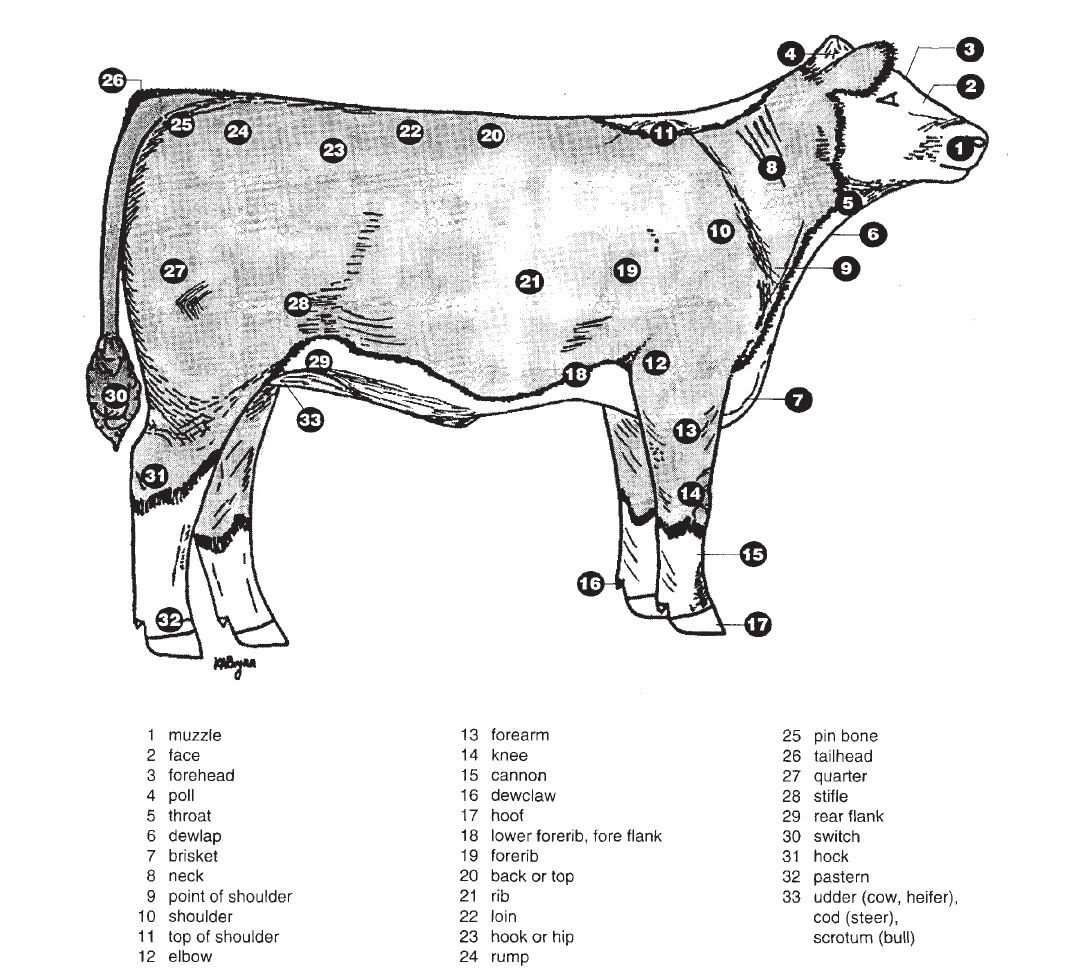
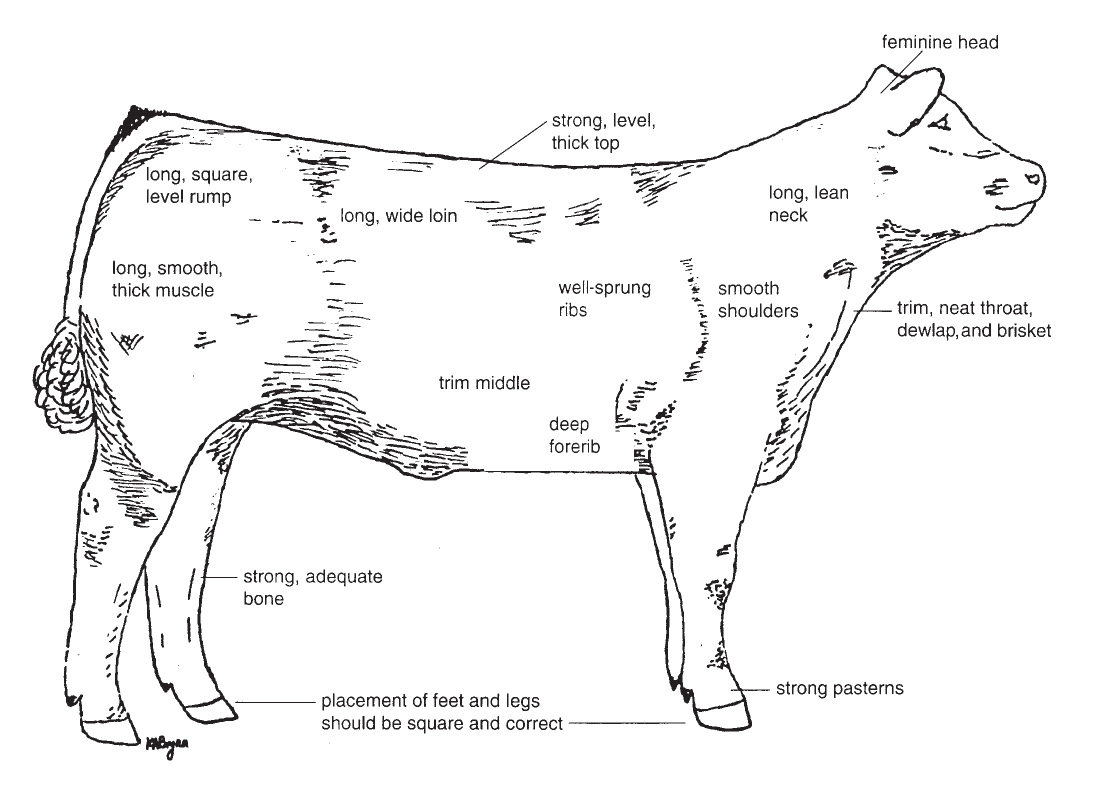
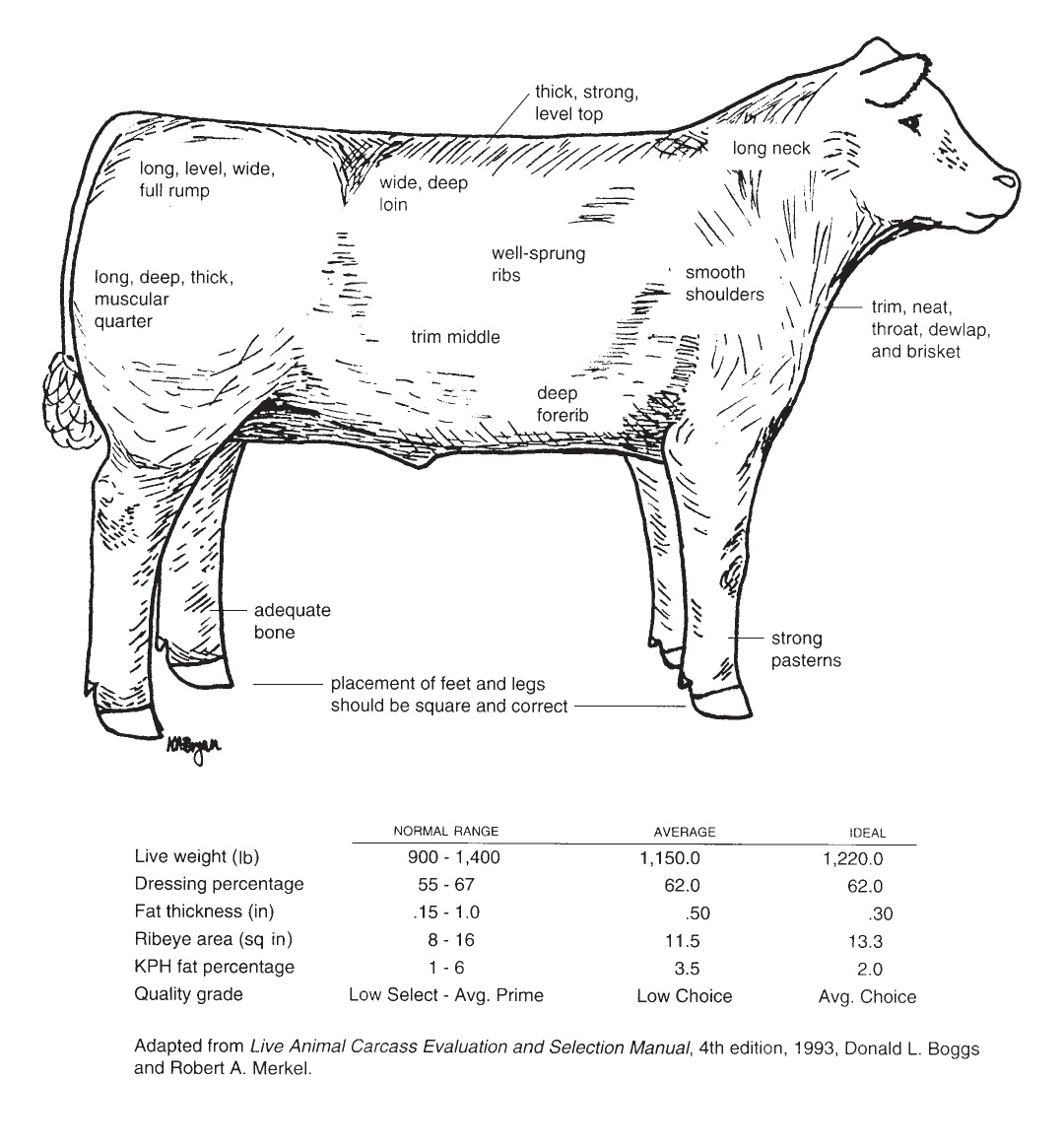
|
|
Normal range |
Average |
Ideal |
|---|---|---|---|
|
Live weight (lb) |
900-1400 |
1150.0 |
1220.0 |
|
Dressing percentage |
55-67 |
62.0 |
62.0 |
|
Fat thickness (in) |
.15-1.0 |
.50 |
.30 |
|
Ribeye area (sq. in) |
8-16 |
11.5 |
13.3 |
|
KPH fat percentage |
1-6 |
3.5 |
2.0 |
|
Quality grade |
Low Select-Avg.Prime |
Low Choice |
Avg. Choice |
Adapted from Live Animal Carcass Evaluation and Selection Manual, 4th edition, 1993, Donald L. Boggs and Robert A. Merkel.
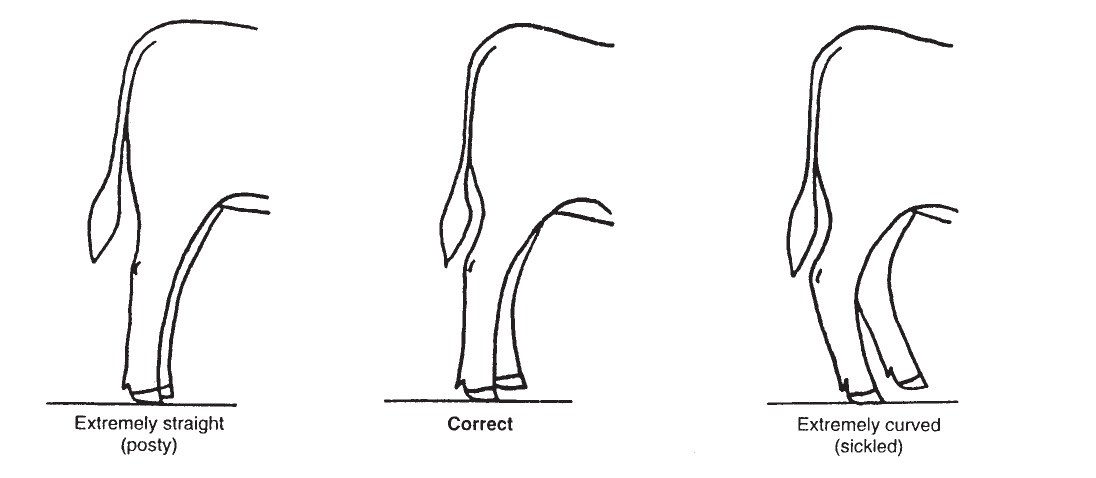
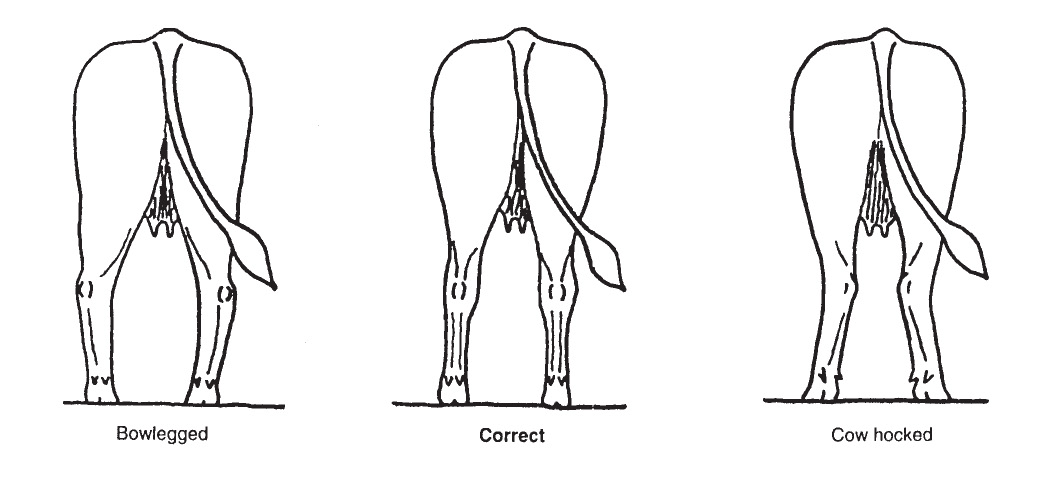
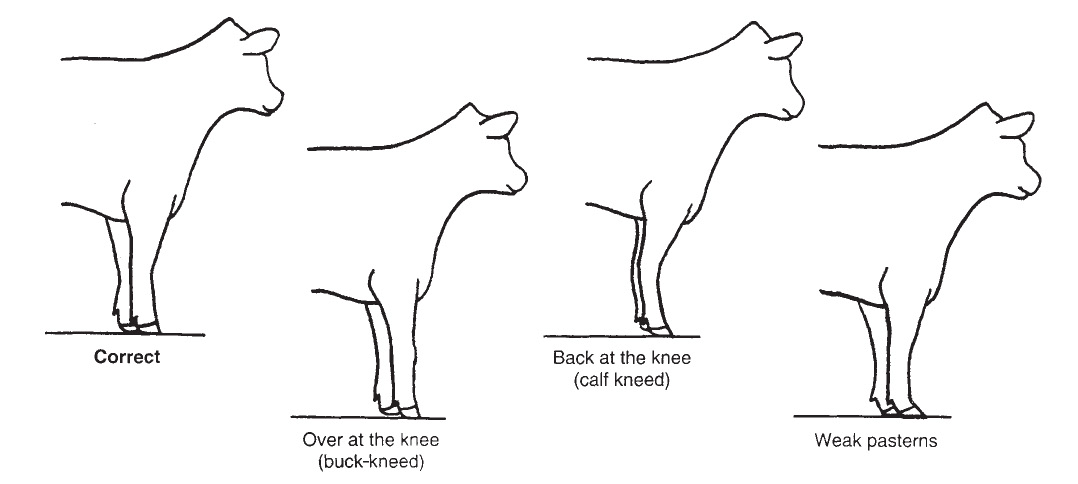

Handling Market Steers
There are no predetermined guidelines for handling steers. The primary objectives when handling steers are to estimate accurately the amount and uniformity of finish and to determine the quantity of muscle in the loin – and maybe in the rump or in the quarter – as an indicator of total muscle volume.
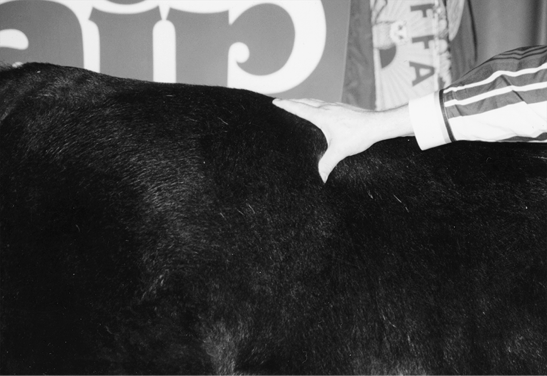
Cup your hand and place the palm of your hand on the loin of the steer and evaluate the depth and width of his loin. The loin should be wide and deep with muscle.



Beef Cattle Terminology
General
More Desirable Characteristics
- more progressive
- more dimensional
- stouter
- more upstanding
- growthier
Less Desirable Characteristics
- conventional
- needs more size and performance
- lacks growth and do-ability
Structure
More Desirable Characteristics
- fault free
- problem free
- straighter lined
- more structurally correct
- better balanced
- tighter framed
- stronger topped, loined
- squarer, leveler rumped
- higher and wider at the pins
- more nearly level in the rump
Less Desirable Characteristics
- ill structured
- poorer structured
- slack framed
- structurally incorrect, poorer structured
- more off-balance, poorly balanced
- weaker topped, loined
- dropped at the pins
- narrower at the pins
- steeper in the rump
Frame and Growth
More Desirable Characteristics
- more moderate framed
- larger framed
- smaller framed
- more size and scale
- longer ______
- more ruggedly designed
- higher weight per day of age
- more performance oriented
Less Desirable Characteristics
- smaller framed or larger framed
- smaller framed
- larger framed
- lacks size and scale
- shorter _______
- finer boned, frailer made
- lower weight per day of age
- lacks growth and performance
Head, Neck, Chest, and Shoulder
More Desirable Characteristics
- fresher appearing
- later maturing
- more future growth potential
- more extended through the front end
- longer, leaner neck
- laid in more neatly about the shoulder
- smoother, tighter shouldered
- smoother neck/shoulder junction
- more desirable slope to the shoulder
- wider chested
Less Desirable Characteristics
- staler appearing
- earlier maturing
- less future growth potential
- shorter fronted
- shorter, leathery fronted
- coarser fronted
- more open shouldered
- coarser neck/shoulder junction
- straight shouldered
- narrower chested
Condition
More Desirable Characteristics
- trimmer, cleaner patterned
- cleaner conditioned
- more ideal in (his/her) condition
- trimmer dewlap, brisket
- easier fleshing
Less Desirable Characteristics
- heavy conditioned
- less ideal in (his/her) condition
- wastier through the front end
- harder doing, harder fleshing
Volume and Capacity
More Desirable Characteristics
- wider sprung
- deeper ______
- more capacious, higher capacity
- bigger volumed
- more dimensional ______
- more arch and spring of rib
- bolder spring of rib
- longer ribbed
- more dimension through center of the rib
Less Desirable Characteristics
- narrower made
- shallower _______
- less capacious
- less volume
- less dimensional _______
- flatter ribbed
- pinched in the forerib
- shorter ribbed
- less dimension through the center of the rib
Muscle and Muscle Design
More Desirable Characteristics
- longer, smoother muscle design
- ______ muscle make-up
- heavier muscled
- thicker made
- deeper quartered
- thicker top
- thicker loin
Less Desirable Characteristics
- shorter, tighter muscle design
- lighter muscled
- shallower quartered
- narrow topped
Feet and Legs
More Desirable Characteristics
- stood on more bone
- heavier boned
- stood on more rugged bone
- stood squarer in (his/her) foot placement
- greater diameter of bone
- stands wider both front and rear
- more desirable set to the hock
- stronger pasterns
Less Desirable Characteristics
- stood on more bone
- finer boned
- stood on finer bone
- splayfooted, pigeon-toed, toes out
- stands narrower both front and rear
- posty legged, sickle hocked
- weak pasterned
Stride and Movement
More Desirable Characteristics
- more mobile
- more fluid moving
- easier moving, sounder footed
- moved out freer and easier
- farther reaching in (his/her) stride
- truer tracking
- longer strided
- moves with more strength of top
- moves with more levelness of rump
Less Desirable Characteristics
- restricted in (his/her) movement
- stiff strided
- narrower tracking, cow hocked
- shorter strided
- roaches (his/her) top on the move
- drops (his/her) pins on the move
Bull
More Desirable Characteristics
- stouter
- more powerful
- cleaner sheath
- neater sheath
- more scrotal circumference
- greater testicular development
- more testicular distention
- more uniform-sized testicles
- testicles hang more correctly
- more ruggedly designed
- wider chested
Less Desirable Characteristics
- pendulous sheath
- less scrotal circumference
- less testicular development
- less testicular distention
- uneven-sized testicles
- twisted testicles
- narrower chested
More Potential to Sire Calves with _______
- frame
- length
- volume
- growth
- muscle
- trimness
- performance
- weight per day of age
Less Potential to Sire Calves with _______
- frame
- length
- volume
- growth
- muscle
- performance
- weight per day of age
Should Sire Calves with more _______
- frame
- length
- volume
- growth
- muscle
- trimness
- performance
- weight per day of age
Should Sire Calves with less _______
- frame
- length
- volume
- growth
- muscle
- performance
- weight per day of age
Heifer
More Desirable Characteristics
- broodier
- more angular
- more stylish
- easier fleshing
- easier keeping
- combines correctness, length, and eye appeal
- nicer brood cow prospect
- larger vulva
- trim-clean navel
Less Desirable Characteristics
- less angular, coarser
- harder fleshing
- harder keeping
- smaller vulva
- loose, wasty navel
Steer
More Desirable Characteristics
- moderate framed
- nicer balanced
- tighter framed
- trimmer, cleaner patterned
- heavier muscled
- more total muscle mass
- wider, thicker topped
- wider, more expressively muscled
- longer ______
- deeper, wider, thicker quarter
- pushes more stifle on the move
- more ideally finished
- handles with ______
- cleaner in his condition
- possesses less waste through ______
- trimmer ______
- should rail a carcass with a ______
- higher lean-to-fat ratio
- more desirable yield grade
Less Desirable Characteristics
- taller
- more off-balance
- slack framed
- heavy middled, off-balance
- lighter muscled
- less total muscle mass
- narrow down his top
- shorter ______
- narrower based, lighter muscled quarter
- patchy, uneven finish
- wastier, fatter, overfinished
- wastier ______
- should rail a carcass with a ______
- lower lean-to-fat ratio
- less desirable yield grade
Performance Data for Beef Cattle
Performance data, or performance records, allow producers to objectively evaluate economically important traits associated with livestock production. The major production traits of beef cattle include the following:
- Measurement of reproductive performance and mothering ability
- Quantification of growth rate and efficiency of gain
- Objective analysis of carcass merit
Performance evaluations can be reported as performance records, or as genetic evaluations of those records and of an animal’s relatives.
In the past several years, an ever-increasing emphasis has been placed on the understanding and use of performance evaluations. The next sections will discuss the importance and application of performance evaluations to beef cattle judging and the combined use of visual appraisal and performance records (actual or genetic) for live animal selection.
Beef cattle performance data can be listed in several different ways. For example, an Angus bull calf might have a 600-pound weaning weight, or a Polled Hereford heifer might have a 750-pound yearling weight. Both of these examples represent actual records of the individual, but they don’t depict how these animals have performed relative to other animals in the herd. Therefore, a more accurate representation of performance would be to rank animals within the same herd. However, ranking animals within the same herd can be biased if they are born at different times of the year or if they are housed and managed differently. Thus, we often need to rank animals within a contemporary group, which is comprised of animals that are of the same breed, age, and sex and that have been raised in the same management group (same location and access to the same feed).
Generally, use a ratio to rank animals within a contemporary group in the herd. A ratio consists of a number, typically around 100 (average), that compares each animal to the other animals in a particular group. Any number below 100 indicates that the animal’s performance was below the average of the group. A ratio of 110 for weaning weight means the animal was 10 percent above average for weaning weight. Likewise, a ratio of 85 for weaning weight means the animal was 15 percent below average for weaning weight. However, use of ratios does not indicate the exact average for a certain trait. Also, ratios may only be used to compare animals within a contemporary group.
When judging livestock and evaluating performance records, select animals for a particular purpose. Ideally, a comparison is made between progeny, or offspring, of one animal with progeny of another animal for a certain economically important trait.
Producers need to be able to compare animals on the same farm that were raised in different contemporary groups or to compare one animal on a particular farm with another animal on a different farm. However, neither actual records nor ratios allow producers to compare animals accurately from different contemporary groups or herds.
In order to compare animals accurately within a breed and across different herds, an expected progeny difference (EPD) must be used. EPDs are a reliable tool to predict the true genetic value of an animal because they consider the individual performance of the animals as well as data from parents, full siblings, and other relatives in all herds that report the information. The biggest advantage is that EPDs allow producers to make comparisons across contemporary groups and herds. However, you cannot compare EPDs of one breed against the EPDs of another breed (example: EPDs of Brangus cannot be compared to the EPDs of Angus). Therefore, a bull with a yearling weight EPD of +55.0 would be expected to sire offspring that are 55 pounds heavier at 365 days of age than offspring from a bull with a yearling weight EPD of 0 (zero). Likewise, a bull with a weaning weight EPD of +45.0 would be expected to sire progeny that are 30 pounds heavier at weaning than the average of the progeny from a bull with a weaning weight EPD of +15.0.
The student who wishes to excel in beef cattle judging must fully understand the importance and accuracy of using actual records on an individual, ratios from within a herd, and EPDs for the following beef cattle production traits:
- Birth Date – The actual date an animal was born.
- Birth Weight – The weight of a calf taken at birth. Heavy births are associated with calving problems and sometimes death of the calf or cow (actual, ratio, or EPD). Birth weight EPDs are more reliable than actual birth weights when predicting calving problems.
- Weaning Weight – The weight of a calf taken between 160 and 250 days of age and then adjusted to a constant age of 205 days (actual, ratio, or EPD).
- Yearling Weight – The weight of an animal taken between 330 and 440 days of age and adjusted to a constant age of 365 days (actual, ratio, or EPD).
- Hip Height or Frame Score – Height at the hip in inches, or height at the hip in inches for a particular age (actual or ratio).
- Maternal Milk EPD – The difference in pounds of a calf expected at weaning because of differences in the milking and mothering ability of the cow.
- Yearling Scrotal Circumference – The distance measured in centimeters around the testicles in the scrotum of a bull at 365 days of age. A greater scrotal circumference indicates that a bull should have the capacity to produce greater volumes of semen, and his progeny should reach puberty at earlier ages (actual or ratio).
When presenting more than one type of data for a particular trait, such as ratios and EPDs for weaning weight, rank and use the data according to the accuracy with which future performance of offspring can be predicted. Give emphasis to the data in the following sequence:
- EPD
- Ratio within a contemporary group
- An individual animal’s actual records
Production Situations for Beef Cattle
The types of beef cattle data and the selection of livestock based solely on visual appraisal have been discussed previously. When practical, use additional information to aid in the selection process. The availability of actual data, ratios, and EPDs allows judges to compare animals using objective criteria of performance. However, without some guidelines, the justifications for various placings of a class with performance data may be even more numerous than the reasons based on visual appraisal alone.
Understanding the scenario is possibly the most important factor when placing a performance class. A scenario is the assumed situation you are in while ranking the class. In each scenario, address three important factors for a complete description:
Breeding Program
- What type of breeding program is being used?
- How are the selected animals to be used in that program?
- What are the goals or objectives of this breeding program?
Feed and Labor Resources
- Under what conditions are the animals being raised?
- Are feed resources readily available or limited?
- Are labor resources readily available or limited?
Marketing Program
- How are the cattle marketed?
- At what age and/or weight are the cattle to be sold?
- For what type of buyer are the cattle being produced?
Using the three factors discussed above, analyze the following three scenarios and data:
Scenario 1
Angus Bulls
These bulls will be used as natural service sires in a two-breed rotational crossbreeding system with Hereford. Cows are medium mature weight and moderate for milk production, and they will be maintained similar to range conditions, with low labor and limited feed availability for larger sizes of cattle. The top 20 percent of heifer calves will be retained as replacements, and the remaining heifer and steer calves will be sold at weaning to be finished in a feedlot.
|
No. |
Birth date |
Birth weight EPD |
Weaning weight EPD |
Yearling weight EPD |
Maternal milk EPD |
|---|---|---|---|---|---|
|
1 (7028) |
2/06/97 |
+2.1 |
+26.0 |
+35.0 |
+5.0 |
|
2 (7126) |
2/25/97 |
+0.9 |
+33.0 |
+59.0 |
+11.0 |
|
3 (7003) |
1/28/97 |
+5.3 |
+29.0 |
+38.0 |
-3.0 |
|
4 (7114) |
2/24/97 |
+4.0 |
+28.0 |
+40.0 |
0.0 |
|
Breed Avg. EPDs: |
+3.0 |
+29.1 |
+52.5 |
+11.5 |
|
Scenario 2
Simmental Heifers
These heifers will be used in a purebred Simmental herd that produces commercial bulls. The bulls will be used on Angus x Polled Hereford crossbred cows and heifers. Mature cow size in the commercial herd is 1,000 to 1,150 pounds. Feed and labor resources in this purebred Simmental herd are adequate to maintain a mature cow size of 1,300 to 1,500 pounds. The primary income is from the sale of commercial bulls, but some income is from the sale of a few purebred bulls and heifers to other purebred Simmental breeders.
|
No. |
Birth date |
Birth weight EPD |
205-day weight EPD |
365-day weight EPD |
Maternal milk EPD |
|---|---|---|---|---|---|
|
1 |
1/30/94 |
+4.7 |
+24.2 |
+44.0 |
+1.5 |
|
2 |
3/01/94 |
+11.1 |
+42.7 |
+68.0 |
+11.0 |
|
3 |
1/22/94 |
+4.0 |
+28.0 |
+51.0 |
+1.0 |
|
4 |
2/11/94 |
+3.8 |
+24.0 |
+53.0 |
+0.8 |
|
Breed Avg. EPDs: |
+3.3 |
+21.0 |
+33.8 |
+0.6 |
|
Scenario 3
Brangus Bulls
Rank these bulls in the order they should be selected as potential herd bulls for a commercial cattle operation. This progressive ranch is looking for a terminal sire to breed to 1,200-pound Black Baldie cows (Angus X Hereford). The progeny from these bulls will be retained by the ranch in the feedlot and sold on a value-based program using a grid that pays premiums for high cutability cattle. Feed and labor resources are abundant.
|
No. |
Tag |
Birth weight EPD |
Weaning weight EPD |
Yearling weight EPD |
Maternal milk EPD |
|---|---|---|---|---|---|
|
1 |
604 |
+3.9 |
+18.2 |
+33.0 |
+4.0 |
|
2 |
666 |
+1.3 |
+9.8 |
+25.0 |
+5.4 |
|
3 |
699 |
-1.5 |
+19.2 |
+43.0 |
-1.0 |
|
4 |
714 |
+3.2 |
+28.5 |
+47.9 |
+1.8 |
|
Breed Avg. EPDs: |
+1.3 |
+15.5 |
+27.1 |
+0.9 |
|
First, describe the breeding program. Is this a purebred or a commercial operation? If cattle are crossbred in this operation, what other breeds are being used? A class of heifers could be replacement females for a purebred program, or a class of bulls could be intended as natural service sires for a purebred or a commercial program. Regardless of the situation, outline an accurate and complete description of the breeding program. Following are analyses of scenario examples of possible breeding programs:
Angus Bulls – Use them as natural service sires in a two-breed rotational crossbreeding system with Hereford. Cows are medium for mature weight and moderate for milk production.
Simmental Heifers – Assume these heifers will be used in a purebred Simmental herd that produces commercial bulls. The bulls will be used on Angus x Polled Hereford crossbred cows and heifers. Mature cow size in the commercial herd is 1,000 to 1,150 pounds.
Brangus Bulls – Use them as natural terminal service sires in a commercial operation with 1,200-pound Black Baldie cows (Angus X Hereford).
Second, discuss the feed and labor resources. Specifically, describe the quality and quantity of feed. For example, cattle that are managed on low-feed resources or range conditions need ample capacity to efficiently use the limited nutrients and probably should not have excessively high milk production. Labor resources will impact body type and birth weight performance records of cattle to be selected. Cattle with high birth weight, coarse shoulders, and narrow rump design with narrow pin placement typically require more physical-labor assistance in the calving process than cattle with low birth weight, smooth shoulders, and wide rump design with added width at the pins. Even with adequate labor available at calving, calves with high birth weights can create unwanted problems and economic hardships for cattle producers. Feed and labor resources are as follows:
Angus Bulls – Cows bred to these bulls will be maintained similar to range conditions, with low labor and limited feed availability for larger sizes of cattle.
Simmental Heifers – Feed and labor resources in this purebred Simmental herd are adequate to maintain a mature cow size of 1,300 to 1,500 pounds.
Brangus Bulls – Feed and labor resources are abundant.
Third, the scenario should discuss the marketing program in enough detail so that performance traits and physical characteristics of the animals can be prioritized. Depending on the marketing program used, place emphasis on traits and characteristics that optimize production of beef cattle for the desired market. Examples follow of marketing programs from each scenario:
Angus Bulls – Retain the top 20 percent of heifer calves as replacements and sell the remaining heifer and steer calves at weaning to be finished in a feedlot.
Simmental Heifers – Sale of commercial bulls is the main benefit, but some income comes from the sale of a few purebred bulls and heifers to other purebred Simmental breeders.
Brangus Bulls – The ranch retains the progeny in the feedlot and sells on a value-based program using a grid that pays premiums for high cutability cattle.
After looking at each part of the scenarios, consider the following priorities:
Scenario 1
Priorities: Select bulls that will maintain mature weight and milk production (maternal traits – birth weight EPD and maternal milk EPD). Maternal traits are very important because top heifers are retained. Remaining heifers and steers are sold at weaning; therefore, paternal traits (weaning weight EPD) are very important.
Scenario 2
Priorities: Maintain a balanced program in all areas. Select cattle that maintain or slightly increase performance in maternal (birth weight EPD and maternal milk EPD) and paternal (weaning weight EPD and yearling weight EPD) traits. Extremes are faulted.
Scenario 3
Priorities: Select bulls that will produce fast-growing calves; therefore, paternal traits (yearling weight EPD) are very important. Material traits in this scenario are not really considered because of the abundance of labor and feed; however, extremes are faulted.
Sample Oral Reasons for Beef Cattle
Prepared by Jeremy White, former Union County 4-H’er
Junior Yearling Brangus Heifers
3-4-2-1
“After analyzing this class of Brangus heifers, my placings were 3-4-2-1. I started with the split-eared heifer in the class, as she was the freest-moving and the longest, smoothest muscled, patterned heifer in the class. I realize 3 could have been heavier muscled throughout; nonetheless, I used 3 over 4 in my top pair, as 3 was a more moderate framed, smoother shouldered heifer that shows more femininity and refinement about her front. She was especially freer from excess leather in the dewlap and brisket and was cleaner and trimmer in the navel. 3 was the most progressive heifer in terms of her muscle length and smoothness, and she moved out with a freer, easier, and more ground-covering stride. She stood on more length of cannon and more closely follows that modern Brangus ideal. I must admit that 4 was a deeper ribbed heifer that showed more thickness down her top and through the center and lower portions of her quarter, while standing on more substance and diameter of bone. However, I would like to see 4 flatter and smoother in her muscle structure and more refined about her front end.
In spite of this, I preferred 4 over 2 in my middle pair, as 4 more closely followed my top heifer in terms of skeletal size and scale. Of the pair, 4 was a larger framed, deeper ribbed, wider sprung, higher capacity heifer that exhibited more total volume and capacity from end to end. She was a more ruggedly made heifer that showed more thickness of muscling down her top and through all dimensions of her quarter. She stood on more substance of bone and more correctly on her feet and legs. I must admit that 2 did more closely follow my top heifer in terms of muscle length and smoothness and was more refined about her front end, but she splayed out up front and was cow hocked.
But I did prefer to use 2 over 1 in my bottom pair of smaller framed heifers, as 2 was a growthier heifer that was cleaner about her middle, trimmer about her front, and showed more youthfulness and growth potential about her head and neck. She was more progressive in her muscle length and smoothness and blended in neater and smoother through her shoulders. She appeared to be a later maturing heifer that should grow into a more progressive and productive herd matron. I must admit that 1 was a straighter, stronger topped, leveler rumped heifer that was more structurally correct, but I faulted 1 and placed her last in this class as she was the smallest framed, lowest set, heaviest fronted heifer that had the most leather in her dewlap, brisket, and navel. She lacked the overall size, scale, balance, and smoothness of the heifers placed above her in the class today. Thank you.”
2-1-4-3
“Selecting the most production-oriented heifer that best combines volume, structural soundness, and balance, I chose the alignment 2-1-4-3 for the Limousin heifers. I realized 2 could be trimmer in her condition and wider tracking, but compared to 1 in my initial pair, she was a broody-appearing, easy-fleshing heifer that carried more length and spring from fore to rear ribs.
Sure, 1 was a stout-made, powerfully constructed heifer, but she was short bodied and restricted in her movement. However, with these faults aside, it was the muscle and volume of 1 over the balance of 4. Also, 1 was wider chested, being deeper and bolder sprung. Likewise, she carried more width and dimension down her top while maintaining this advantage into a more three-dimensional quarter.
Yes, 4 was a more feminine-fronted heifer, but at the same time, she was narrow tracking off both ends and tapered through her lower quarter. Even so, in my concluding pair, 4 beat 3. She was a more attractive profiling, more eye-appealing heifer that was more angular fronted. In addition, she was straighter, stronger down her top, and longer and leveler out of her hip, allowing her to be longer striding off her rear legs.
I realize 3 was a long-bodied, deep-sided heifer. However, this does not allow for the fact that she was the narrowest made, lightest muscled heifer that was the poorest structured; so she was last. Thank you.”
4-2-1-3
“My placing of the market steers is 4-2-1-3. I started the class with 4, the most powerfully muscled, most correctly finished steer in the class. I realize he was wastier fronted and middled; nonetheless, I used 4 over 2 in my top pair because he was a thicker made, heavier muscled steer throughout. He was a leveler topped steer that was longer in his rump. He had more thickness working down his top and out through a fuller rump. As viewed from behind, he had more thickness of muscle in the upper and center portions of his quarter and pushed more stifle on the move. He handled with more condition over his loin edge and down over his rib and should be more apt to reach that Choice quality grade. However, I do realize that 2 was a cleaner middled, trimmer fronted steer, but he simply lacked the volume and dimension of muscle of my top steer.
Concerning my middle pair, I placed 2 over 1, as 2 was a longer bodied, more upstanding steer that was trimmer through his front and middle. As viewed from behind, he had more thickness through the center and lower portions of his quarter and should go to the rail and hang a higher cutability carcass. I will admit that 1 was a deeper ribbed, wider sprung, higher capacity steer that stood down on more substance of bone. Also, he was a squarer rumped steer that was more ideal in the amount and uniformity of his finish.
I confidently placed 1 over 3 in my bottom pair, as he was a thicker made, heavier muscled steer that was more nearly ideal in his finish. He had more natural thickness down his top and through his quarter. He should hang a heavier muscled carcass that should be more likely to grade Choice. I do realize that 3 was a trimmer made steer, having less waste throughout. However, he was the lightest muscled, most underfinished steer of the class. He would hang up the least merchandizable carcass and, therefore, cannot merit a higher placing today. Thank you.”
1-4-2-3
“With the given scenario in mind, I placed my emphasis on weaning and yearling weight expected progeny differences as well as structural correctness and found that 1 best satisfied the scenario.
I realize 1 was not the highest in his growth data. Even so, the dehorned bull easily beats 4 in the top pair as he was the heaviest muscled, nicest balanced, easiest fleshing bull in the class. Plus, he’s the deepest ribbed, the heaviest boned, and the straightest in his lines.
Yes, 4 had the highest weaning and yearling weight EPDs, but he was also the poorest structured bull that was straight in his shoulder and hock, was steep hipped, and was restricted in his movement, so he’s second.
Still, I opted to use 4 over 2 in the middle pair, as 4 simply dominated in terms of weaning and yearling weight EPDs. In addition, he’s a larger framed bull that was stronger topped, smoother shouldered, and cleaner fronted.
I admit 2 was leveler hipped and took a longer, freer stride from behind, but his weaning weight EPD of +6.9 was the lowest in the class; he’s deep and course fronted, weak topped, and sickle hocked, so he’s third.
Even so, I used 2 over 3 in the bottom pair as he’s higher in his yearling weight EPD. He was thicker down his top and through his quarter, leveler hipped, and he tracked wider based behind.
I realize 3 was taller fronted, deeper ribbed, and straighter on his hind legs. But, at 9.7, he had the lowest yearling weight EPD of the class. He was the lightest muscled, narrowest chested, hardest doing bull that’s steep hipped and twisted in his scrotum, so he’s last. Thank you.”
Sheep
Breeds of Sheep
Table 5 outlines some of the breeds of sheep that are common in the United States. Each breed has been assigned a breed class (ram, ewe, or dual) according to whether the dominant characteristics of the breed are associated with growth and carcass traits (ram) or reproductive characteristics (ewe). The dual breed class indicates that the breed is noted equally for growth, carcass, and reproductive characteristics.
Average weights for mature rams and ewes are listed. Again, these are included to allow you to compare one breed with another breed. The weights and other characteristics listed are breed averages; there is as much variation within a breed as there is among breeds for these traits.
Growth rate, hardiness, gregariousness, prolificacy, and milking ability are ranked among breeds, using a 6-point scale, with 1 as the most desirable and 6 as the least desirable. Fleece weight is given in pounds of wool per year from the average animal of that breed. Fleece type is listed as either fine, medium, or long and describes the type of wool fiber characteristic of the breed.
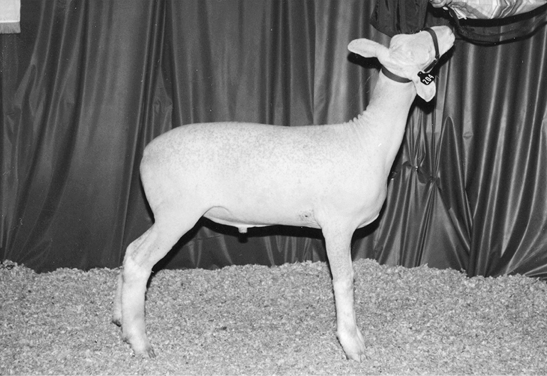

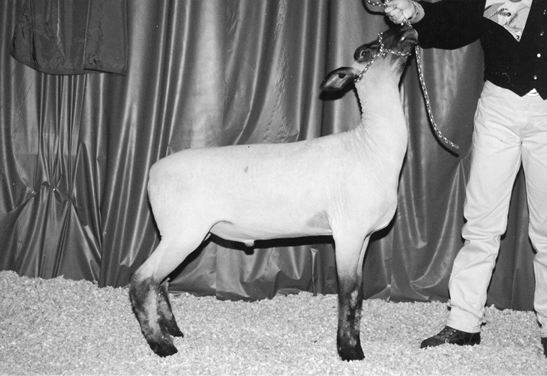

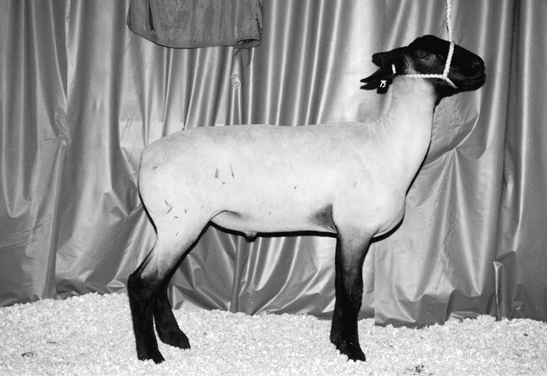
|
Breed |
Breed class |
Ram wt. |
Ewe wt. |
Growth ratea |
Hardinessa |
Gregariousnessa |
Prolificacya |
Milking abilitya |
Fleece weight |
Wool type |
Face color |
|---|---|---|---|---|---|---|---|---|---|---|---|
|
Border Leicester |
ram |
210 |
160 |
4 |
6 |
6 |
3 |
3 |
9 |
long |
white |
|
Cheviot |
ewe |
180 |
135 |
4 |
4 |
6 |
4 |
4 |
5 |
medium |
white |
|
Columbia |
dual |
260 |
165 |
2 |
4 |
4 |
4 |
4 |
11 |
medium |
white |
|
Corriedale |
ewe |
190 |
140 |
5 |
4 |
4 |
4 |
4 |
11 |
medium |
white |
|
Debouillet |
ewe |
190 |
140 |
5 |
2 |
2 |
5 |
5 |
11 |
fine |
white |
|
Delaine |
ewe |
195 |
130 |
5 |
2 |
2 |
5 |
5 |
11 |
fine |
white |
|
Dorset |
dual |
225 |
170 |
3 |
6 |
6 |
3 |
2 |
6 |
medium |
white |
|
Finnsheep |
ewe |
200 |
140 |
5 |
6 |
6 |
1 |
2 |
6 |
medium |
white |
|
Hampshire |
ram |
275 |
200 |
2 |
6 |
6 |
3 |
2 |
7 |
medium |
black |
|
Lincoln |
dual |
300 |
225 |
5 |
6 |
6 |
4 |
5 |
12 |
long |
white |
|
Montdale |
ram |
235 |
160 |
4 |
5 |
6 |
4 |
4 |
8 |
medium |
white |
|
Oxford |
ram |
250 |
190 |
3 |
6 |
6 |
4 |
4 |
8 |
medium |
brown |
|
Rambouillet |
ewe |
225 |
160 |
3 |
2 |
2 |
5 |
5 |
11 |
fine |
white |
|
Romney |
dual |
220 |
175 |
5 |
6 |
6 |
4 |
5 |
10 |
long |
white |
|
Shropshire |
ram |
235 |
170 |
3 |
5 |
6 |
3 |
3 |
8 |
medium |
dark brown |
|
Southdown |
ram |
200 |
145 |
4 |
6 |
6 |
4 |
4 |
5 |
medium |
light brown |
|
Suffolk |
ram |
300 |
215 |
1 |
6 |
6 |
2 |
2 |
5 |
medium |
black |
|
Targhee |
ewe |
250 |
175 |
3 |
4 |
4 |
4 |
4 |
11 |
medium |
white |
aRanking based on 1 (most desirable) through 6 (least desirable).
(Adapted from The Sheepman’s Production Handbook, 1982, George E. Scott, editor)
Parts of Sheep
Become familiar with the parts and carcass regions of sheep. In this section, you are provided diagrams of the external parts of sheep (Figure 11), characteristics of an ideal breeding ewe (Figure 12), and characteristics of an ideal market wether (Figure 13). After becoming familiar with all the parts, use those terms as part of your reasons.
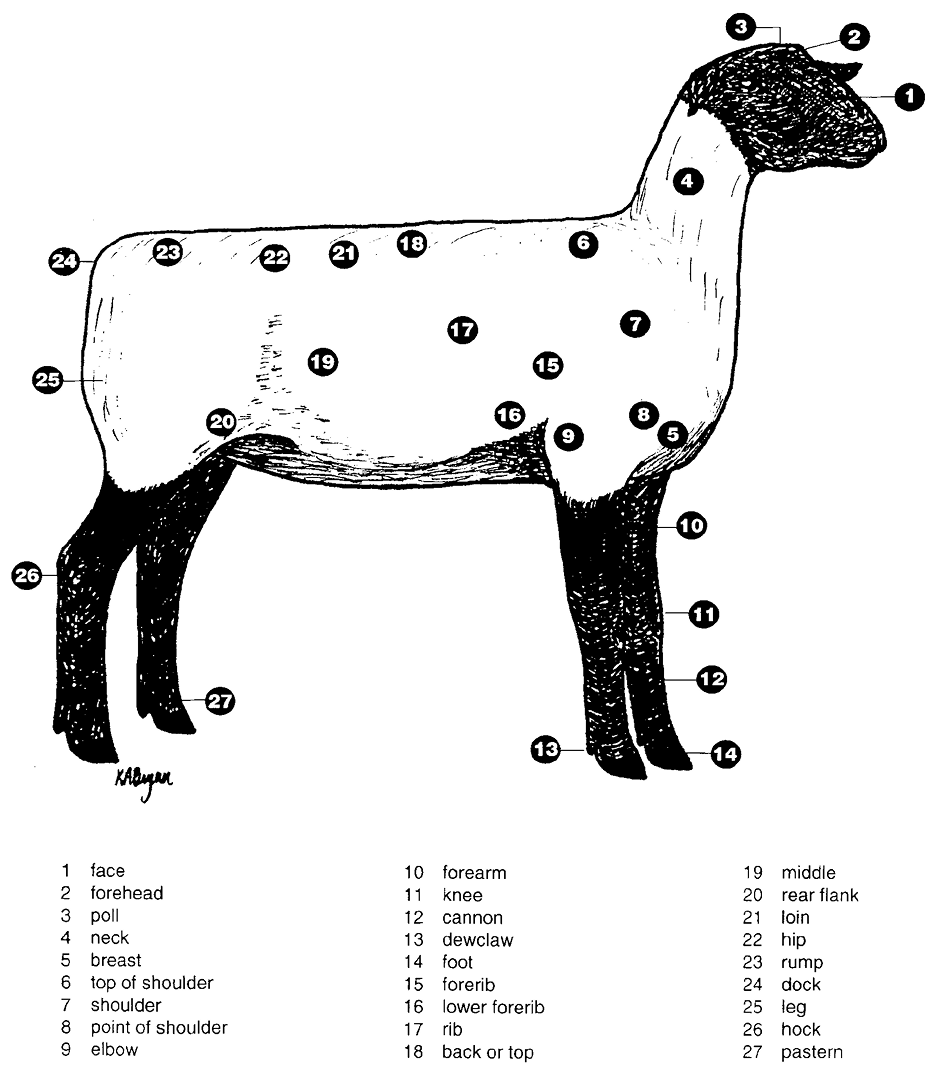

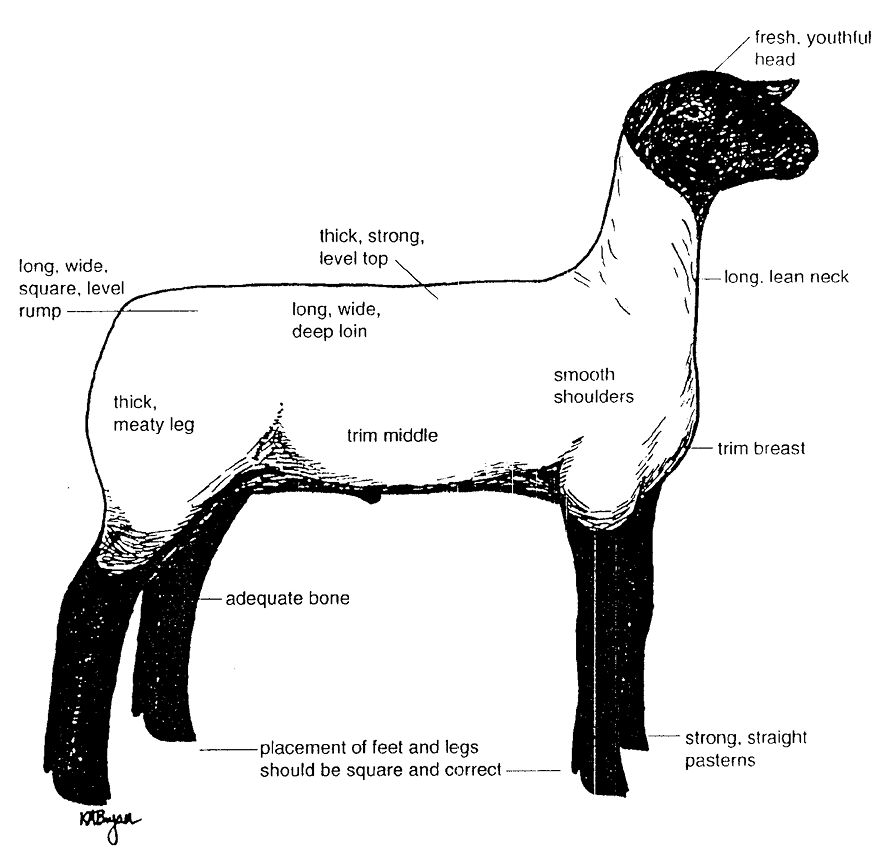
|
|
Normal Range |
Average |
Ideal |
|---|---|---|---|
|
Live weight (lb) |
|
110.0 |
120.0 |
|
Dressing percent |
|
52.0 |
52.0 |
|
Fat thickness (in) |
|
.30 |
.12 |
|
Ribeye area (sq. in) |
|
2.25 |
2.80 |
|
KP fat percent |
|
3.5 |
2.0 |
|
Leg Score |
|
|
|
Adapted from Live Animal Carcass Evaluation and Selection Manual, 4th edition, 1993, Donald L. Boggs and Robert A. Merkel.
Handling Market Lambs
One key to handling market lambs is to develop a system to accurately determine differences in muscle and finish. Handle each lamb in the same manner. If you handle one lamb from rear to front for finish or fleshing on the back, handle all the lambs that way. Following are the steps for handling market lambs:
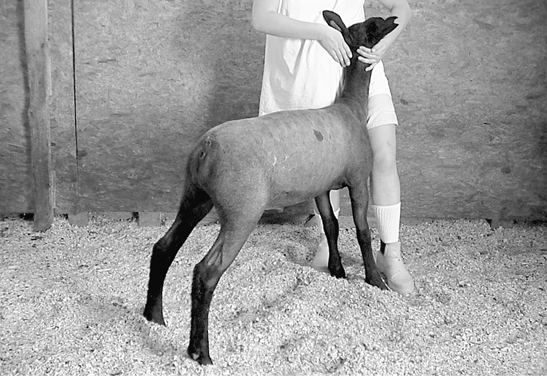



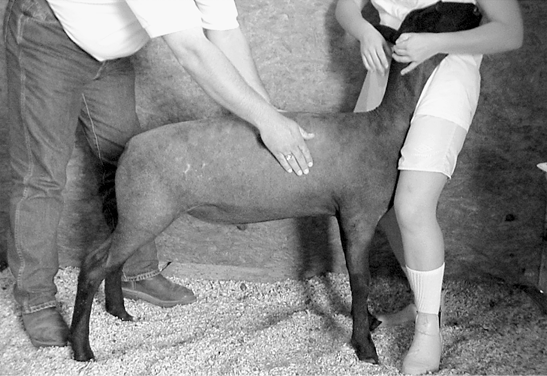
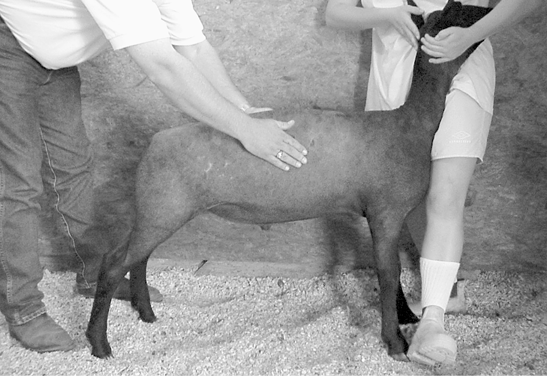
Step 7. The final location used to determine the finish of a lamb is at the last rib. Lambs should feel trimmer at the last rib compared with the forerib. Trim, muscular lambs are firm and hard when handled. Fat lambs are soft to the touch, and it is difficult to distinguish the bones of the shoulder, spine, and ribs.
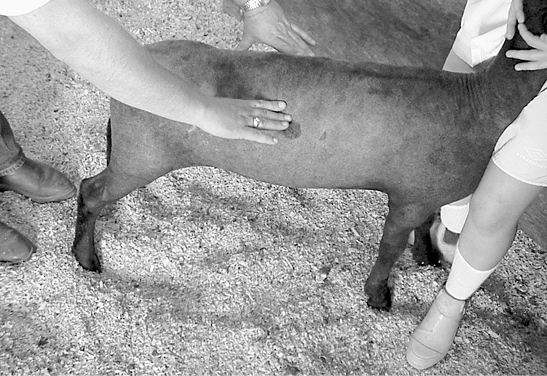

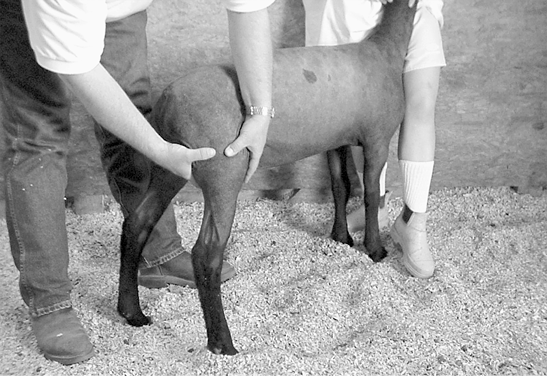
Sheep Terminology
General
More Desirable Characteristics
- more progressive
- more dimensional
- stouter
- more upstanding
- growthier
Less Desirable Characteristics
- conventional
- needed more size and performance
- low fronted
- lacked growth and do-ability
Structure
More Desirable Characteristics
- more fault free
- more problem free
- straighter lined
- more structurally correct
- nicer balanced
- tighter framed
- stronger topped, loined
- squarer, leveler rumped
- more nearly level in (his/her) rump
Less Desirable Characteristics
- ill structured
- poorer structured
- slack framed
- structurally incorrect, poorer structured
- off balance
- weak topped, weaker loined
- dropped at the dock
- steeper in (his/her) rump
Frame and Growth
More Desirable Characteristics
- larger framed
- more size and scale
- longer _______
- more ruggedly designed
- higher weight per day of age
- more performance oriented
Less Desirable Characteristics
- smaller framed
- lacked size and scale
- shorter _______
- finer boned
- lower weight per day of age
- lacked growth and performance
Head, Neck, and Shoulder
More Desirable Characteristics
- fresher appearing
- later maturing
- more future growth potential
- more extended through the front end
- longer, leaner neck
- laid in more neatly about the shoulder
- smoother, tighter shouldered
- smoother neck/shoulder junction
- more desirable slope to (his/her) shoulder
Less Desirable Characteristics
- staler appearing
- earlier maturing
- less future growth potential
- shorter fronted
- shorter, more pelty in (his/her) neck
- coarser fronted
- more open shouldered
- coarser neck/shoulder junction
- straighter shouldered
Condition
More Desirable Characteristics
- trimmer, cleaner patterned
- cleaner conditioned
- more ideal in (his/her) condition
- trimmer breasted
- easier fleshing
Less Desirable Characteristics
- heavier condition
- wastier through (his/her) breast
- harder fleshing, harder doing
-
Volume and Capacity
-
More Desirable Characteristics
- wider sprung
- deeper _______
- higher capacity
- more capacious
- more internal volume
- more dimensional _________
- more arch and spring of rib
- bolder spring of rib
- more dimension through the center of the rib
Less Desirable Characteristics
- narrower made
- shallower _________
- shallower bodied, tighter ribbed
- less capacious
- less internal volume
- less dimensional _______
- flatter ribbed
- pinched or constricted in the forerib
- less dimension through the center of the rib
Muscle
More Desirable Characteristics
- longer, smoother muscle design
- _______ muscle make-up
- heavier muscled
- thicker made
- more expressively muscled in (his/her) leg
Less Desirable Characteristics
- shorter, tighter muscle design
- lighter muscled
- lighter muscled in (his/her) leg
Feet and Legs
More Desirable Characteristics
- stood on more bone
- heavier boned
- stood on more rugged bone
- stood squarer in (his/her) foot placement
- stood wider both front and rear
- more desirable set to the hock
- stronger pasterns
Less Desirable Characteristics
- stood on finer bone
- finer boned
- splayfooted, pigeon-toed, toes out
- stood narrower both front and rear
- posty legged, sickle hocked
- weaker pasterns
Stride and Movement
More Desirable Characteristics
- more mobile
- more fluid moving
- easier moving, sounder footed
- moved out freer and easier
- farther reaching in (his/her) stride
- truer tracking
- longer strided
- moved with more strength of top
- moved with more levelness of rump
Less Desirable Characteristics
- restricted in (his/her) movement
- stiffer strided
- shorter strided
- narrower tracking, cow hocked
- roached with (his/her) top on the move
- dropped (his/her) dock on the move
Fleece
More Desirable Characteristics
- freer from black fiber
- tighter, denser fleece
- fleece with finer crimp
Less Desirable Characteristics
- possessed black fiber _______
- pencil fleece, more open fleece
- cottony fleece
Ram
More Desirable Characteristics
- greater scrotal circumference
- “buck”
Less Desirable Characteristics
- smaller scrotal circumference
More Potential to Sire Lambs with _______
- frame
- length
- volume
- balance
- growth
- muscle
- trimness
- performance
- weight per day of age
Less Potential to Sire Lambs with_______
- frame
- length
- growth
- muscle
- performance
- weight per day of age
Should Sire Lambs with more _______
- frame
- length
- volume
- growth
- muscle
- trimness
- performance
- weight per day of age
Should Sire Lambs with less _______
- frame
- length
- balance
- growth
- muscle
- performance
- weight per day of age
Ewe
More Desirable Characteristics
- broodier
- brood ewe prospect
- more feminine
- more stylish
- more capacious
Less Desirable Characteristics
- coarser fronted
- less capacious
Wether
More Desirable Characteristics
- muscle and trimness
- trimmer, cleaner patterned
- trimmer fronted
- cleaner, harder handling
- firmer handling
- handled with ______
- heavier muscled
- more dimensional leg
- wider, fuller rump
- heavier muscled hindsaddle
- should hang a carcass with _____
- should rail a _____ carcass
- trimmer, higher cutability carcass
- carcass with more leg muscle
Less Desirable Characteristics
- wastier fronted, pelty
- overfinished, fatter, wastier
- softer handling
- lighter muscled
- narrower, lighter muscled leg
- narrower rump, pinched at (his/her) dock
- lighter muscled hindsaddle
Performance Data for Sheep
Much like performance data for beef cattle, performance data for sheep can be listed in several different ways. Both actual data and ratios are used to select animals that are superior for lamb and wool production. Performance data are important for selecting replacement animals and culling poor-producing animals. In judging classes, stud rams or ewes in production are typically not evaluated. Therefore, the use of performance data for selecting replacement ewes and potential stud rams is of primary concern.
Familiarize yourself with the following sheep production traits and the associated terms in order to understand performance data for sheep:
- Birth Date – Actual date an animal was born.
- Birth Weight – The weight of a lamb taken within 24 hours after birth. Heavy birth weights are associated with lambing problems (actual, ratio).
- Type of Birth and Type of Rearing – The number of lambs born and raised by a ewe. The following designations are used: S-single, TW-twin, TR-triplet, and Q-quadruplet (Examples: Type of birth-TW, Type of rearing-S).
- Preweaning and Postweaning Weights – Considerable variation exists among sheep producers for age at weaning. Because all performance records for sheep are to be evaluated within a flock, preweaning and postweaning weights will be listed according to management procedures for a particular flock.
Age-Weight Categories – The weight of a lamb adjusted to a particular age (actual, ratio, EPD). Standard age-weight categories for sheep according to National Sheep Improvement Program (NSIP) guidelines are as follows:
|
Age-Weight Category |
Allowable Range in Age |
|---|---|
|
30-day |
23 to 37 days |
|
60-day |
38 to 83 days |
|
90-day |
68 to 113 days |
|
120-day |
98 to 143 days |
|
180-day |
150 to 210 days |
|
365-day |
335 to 395 days |
- Weaning Weight – A specified weaning weight will be given for one of the age-weight cate gories listed on the last page. Usually, weaning weight corresponds with 30-, 60-, 90-, or 120-day weight (actual, ratio, EPD).
- Yearling Weight – The weight of a sheep taken after 335 days of age and before 395 days of age and adjusted to a constant age of 365 days (actual, ratio, EPD).
- Fleece Quantity and Quality – Wool measurements on an animal are taken only once in its lifetime and should be measured at approximately 1 year of age. Wool measurements include the following:
- Grease Weight – Weight of the freshly shorn fleece in pounds to the nearest tenth of a pound.
- Clean Weight – Weight of the cleaned fleece in pounds to the nearest tenth of a pound, as determined by a wool testing laboratory.
- Staple Length – Length of the unstretched wool fibers in inches to the nearest tenth of an inch, obtained from the midside area of the animal.
- Grade – Fleece grade is recorded to the nearest tenth of a micron (1 micron = 1/25,400 inch).
Expected Progeny Differences (EPDs) for Sheep
In the past, data were calculated only as FEPDs, which is the same as EPDs except that all the data were derived from a single flock. The “F” stands for “Flock.” However, FEPDs do not use across-flock data.
FEPDs were used for several years because across-flock analyses for sheep were not feasible. There was not enough reliable information on identifiable genetic linkages between flocks. Today, however, across-flock EPDs provide far more information about genetic value than FEPDs because they are derived from many flocks and over different management systems.
By using EPDs, a breeder can make genetic improvements efficiently and reliably. EPDs allow a breeder to rank all the animals by genetic value, identify high-producing replacements, and cull poor-producing animals.
EPDs for sheep are developed primarily for these economically important traits:
Maternal EPDs
- Number of Lambs Born – A positive EPD indicates the ewe has the capability to produce more lambs than a ewe with a 0 (zero) or negative EPD for this trait. This EPD is an indica tor of prolificacy, or the genetic ability of the ewe to produce lambs.
- Maternal Milk – This trait refers to the difference in pounds of a lamb/lambs expected at weaning because of differences in milking and mothering ability of the ewe. An EPD of +6.0 means the ewe should wean lambs that are 6 pounds heavier at weaning than lambs produced by a ewe with a EPD of 0.
Growth EPDs
- Weights at Preweaning, Weaning, and Postweaning – These EPDs correspond to the age- weight categories of 60-, 90-, 120-, 180-, and 365-day weights in lambs and are used to evaluate the genetic merit for growth.
- In each instance, the age should be listed also. These EPDs are very similar to and should be interpreted much like the EPDs for other age-weight listings (Example: 205-day weight in beef cattle).
Wool EPDs
- Wool EPDs are calculated for grease fleece weight, fiber length, and fiber diameter.
Production Situations for Sheep
As in the beef cattle section, three classes of sheep with performance data are included as examples of different scenarios and ways of presenting performance data. Also, the priorities of each are listed.
Scenario 1
Suffolk Ram Lambs
Rank these rams as you would use them for stud rams in a purebred Suffolk flock. Feed and labor resources are more than adequate to maintain the flock of ewes. You profit mainly from selling rams and ewes to other purebred Suffolk breeders, and a few rams to commercial sheep producers. You retain your own replacement ewes.
|
No. |
Birth type |
Birth rearing |
Birth weight |
Lambs born |
Maternal milk |
Growth: 60-day weight |
Growth: 365-day weight |
Dam’s fleece weight |
|---|---|---|---|---|---|---|---|---|
|
1 |
TW |
TW |
9.3 |
-.042 |
+4.1 |
+1.2 |
+3.2 |
-0.1 |
|
2 |
S |
S |
12.0 |
+.041 |
+6.1 |
+3.1 |
+9.7 |
+0.4 |
|
3 |
TW |
S |
10.2 |
+.036 |
+5.0 |
+2.0 |
+10.3 |
+0.2 |
|
4 |
TR |
TW |
9.6 |
-.022 |
+3.7 |
+1.3 |
+5.3 |
+0.1 |
Scenario 2
Dorset Fall Ewe Lambs
Rank these ewes as you would use them as replacement ewes in a purebred flock of Dorset sheep. You sell a few rams to other purebred Dorset breeders, but you mainly profit from the sale of rams and ewes to commercial sheep operations.
|
No. |
Birth date |
Birth type |
Rearing type |
Birth weight |
Weight (60-day adjusted) |
Ratio (60-day adjusted) |
Weight (120-day adjusted) |
Ratio(120-day adjusted) |
Dam’s fleece weight |
|---|---|---|---|---|---|---|---|---|---|
|
1 |
9/5 |
S |
S |
12.0 |
61 |
91 |
120 |
97 |
8.6 |
|
2 |
9/7 |
TW |
TW |
7.5 |
66 |
99 |
123 |
99 |
7.5 |
|
3 |
9/20 |
TW |
TW |
8.5 |
72 |
108 |
130 |
105 |
10.4 |
|
4 |
9/22 |
TR |
TR |
10.5 |
76 |
114 |
136 |
109 |
9.5 |
Scenario 3
Yearling Hampshire Rams
Assume these rams are terminal sires to be used on Rambouillet x Dorset crossbred ewes for production of feeder lambs. All lambs are finished in a feedlot on the farm. Ewes are maintained on range conditions, typical of sheep production operations in the Rocky Mountain states.
|
No. |
Birth date |
Birth type |
Rearing type |
Birth weight |
Lambs born |
30-day weight |
Growth: 120-day weight |
Growth: 180-day weight |
|
1 |
2/5 |
S |
S |
12.3 |
-.010 |
+2.6 |
+5.2 |
+8.2 |
|
2 |
2/7 |
S |
S |
14.0 |
+.060 |
+1.9 |
+3.2 |
+4.4 |
|
3 |
2/20 |
TW |
S |
10.2 |
+.210 |
-1.6 |
-2.2 |
-8.2 |
|
4 |
2/22 |
TR |
TR |
9.6 |
+.122 |
+1.1 |
+4.4 |
+9.7 |
After looking at the three scenarios, consider the following priorities:
Scenario 1
Priorities: Balanced program in all areas. Select rams that maintain or slightly increase maternal and growth traits, but extremes ones are to be faulted.
Scenario 2
Priorities: Again, this is a balanced program; however, more emphasis should be placed on growth traits because rams and ewes are sold to commercial operations.
Scenario 3
Priorities: Select rams that will improve the growth traits. Growth is very important because all lambs are finished in a feedlot.
Sample Oral Reasons for Sheep
3-2-1-4
“My placing of the Dorset ewes was 3-2-1-4. I found a top pair of more modern-type ewes and started the class with the combination ewe in 3. Ideally, I would have liked to see 3 with more capacity in the forerib. Even so, I placed 3 over 2 as she was a leveler-topped, leveler-rumped ewe that was more progressive in her type and muscle makeup. She was a stretchier ewe that put a longer, smoother muscle structure onto a longer skeletal framework, and she was taller. She was a cleaner fronted, more feminine-headed female. However, I concede that 2 had more arch and spring to her forerib.
Nevertheless, I placed 2 over 1 in my middle pair, as 2 more closely followed the type and pattern set by my top ewe. She was a more feminine-fronted ewe that was laid in tighter about her shoulder, was longer and leaner about her neck, and exhibited more femininity about her head. She was a longer bodied ewe that was higher at her dock and had a more desirable set to her hock. I will admit that 1 was a thicker made ewe, although she was weaker on her rear pasterns.
With this in mind, it was 1 over 4 in my final comparisons. 1 was a longer bodied, larger framed ewe that had more natural thickness of muscle and more total volume and capacity. She was a longer bodied ewe that was trimmer in her breeding condition. However, I realize that 4 was a smoother shouldered ewe, but she was the smallest framed, shortest bodied ewe that was the most conventional in her type. Thank you.”
1-2-3-4
“My placing of the market lambs was 1-2-3-4. I started with 1, the growthiest, most correctly finished lamb in the class. Ideally, I would have liked to see 1 with more muscling throughout. Nonetheless, I placed 1 over 2 as he was a trimmer made lamb that was cleaner and neater about his front end. He handled with less finish over his rib and was a larger framed, longer bodied lamb. He should go to the rail and hang a trimmer, higher cutability carcass. I realized that 2 was a heavier muscled lamb that had more dimension of muscle in his loin, over his rump, and down through his leg, but he was a softer handling, heavier finished lamb.
Nevertheless, I placed 2 over 3 in my middle comparison because 2 was a larger framed, taller fronted lamb that handled with a longer hindsaddle. He was a heavier muscled lamb that was leveler and fuller through his rump. He was a more structurally correct wether that should go to the rail and hang up a heavier muscled carcass. I admit that 3 was the most correctly finished lamb in the class, but he simply lacked the growth, scale, and total muscle volume of the two lambs placed above him.
Still, I opted to use 3 over 4 because 3 was more correctly finished than 4. He was a firmer handling lamb that had more dimension and expression of muscle in his leg. He should rail a trimmer finished carcass with more total pounds of muscle. Yes, 4 was a larger framed lamb, but he was a wastier, heavier conditioned, and lighter muscled lamb that should hang up the least profitable carcass in the class. Thank you.”
Swine
Breeds of Swine
The following table compares characteristics of the breeds of swine that are common in the United States.
A 5-point scale is used, with 1 and 2 representing a breed that is above average for a particular trait, 3 is average for the trait, and 4 and 5 are below average for the trait.
Litter size and litter weight are characteristics associated with reproductive performance of females in the herd. Growth rate and feed efficiency are traits related to an animal’s ability to grow rapidly and convert feed to body weight. Backfat thickness and loineye area describe the relative merits of market animals to yield muscular, trim carcasses.
The ear set of swine is either erect or down. That ear characteristic will help you distinguish some breeds from others.
|
Breed |
Litter Size |
Litter Weighta |
Growth Ratea |
Backfat Thicknessa |
Loin Muscle Areaa |
Ear Seta |
Characteristics |
|---|---|---|---|---|---|---|---|
|
Berkshire |
4 |
4 |
—— |
3 |
3 |
erect |
black with white on face, legs, possibly the switch |
|
Chester White |
1 |
4 |
5 |
3 |
3 |
down |
solid white |
|
Duroc |
3 |
3 |
2 |
3 |
3 |
down |
solid red, from bright orange to chocolate-red |
|
Hampshire |
4 |
3 |
4 |
1 |
2 |
erect |
black with white belt across the front legs |
|
Landrace |
1 |
1 |
3 |
5 |
4 |
down |
solid white |
|
Poland China |
—— |
—— |
3 |
2 |
2 |
down |
black with white face, legs, possibly the switch |
|
Spotted |
5 |
4 |
2 |
4 |
2 |
down |
white with black spots |
|
Yorkshire |
1 |
2 |
2 |
4 |
3 |
erect |
solid white |
aRanking based on 1 (most desirable) through 5 (least desirable). Insufficient data for comparsion is indicated by (——).
Adapted from the Pork Industry Handbook, 1985 Purdue University Cooperative Extension Service.




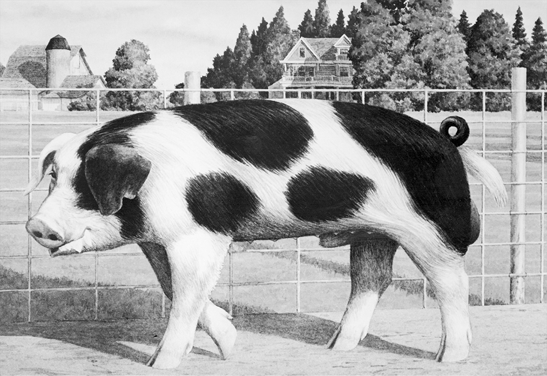
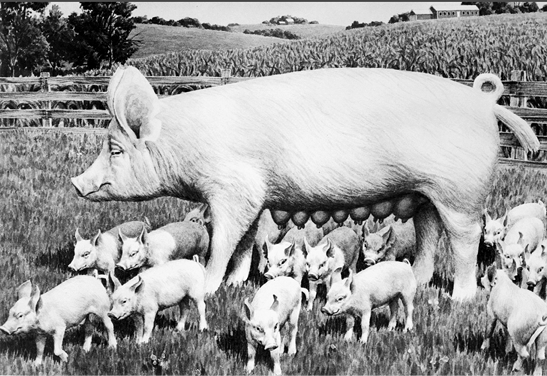
Parts of Swine
After you have become familiar with the breeds of swine, learn the external parts and carcass regions. This section provides diagrams of the external parts (Figure 14), characteristics of an ideal breeding gilt (Figure 15), and characteristics of an ideal market barrow (Figure 16). Take time to study all of the parts and to become familiar with them so you can refer to them without hesitation. Use these terms as part of your reasons.
Characteristics of the ideal breeding gilt and the ideal market barrow are included for reference only. Depending on the location and production situation, an ideal can take on various shapes and forms.
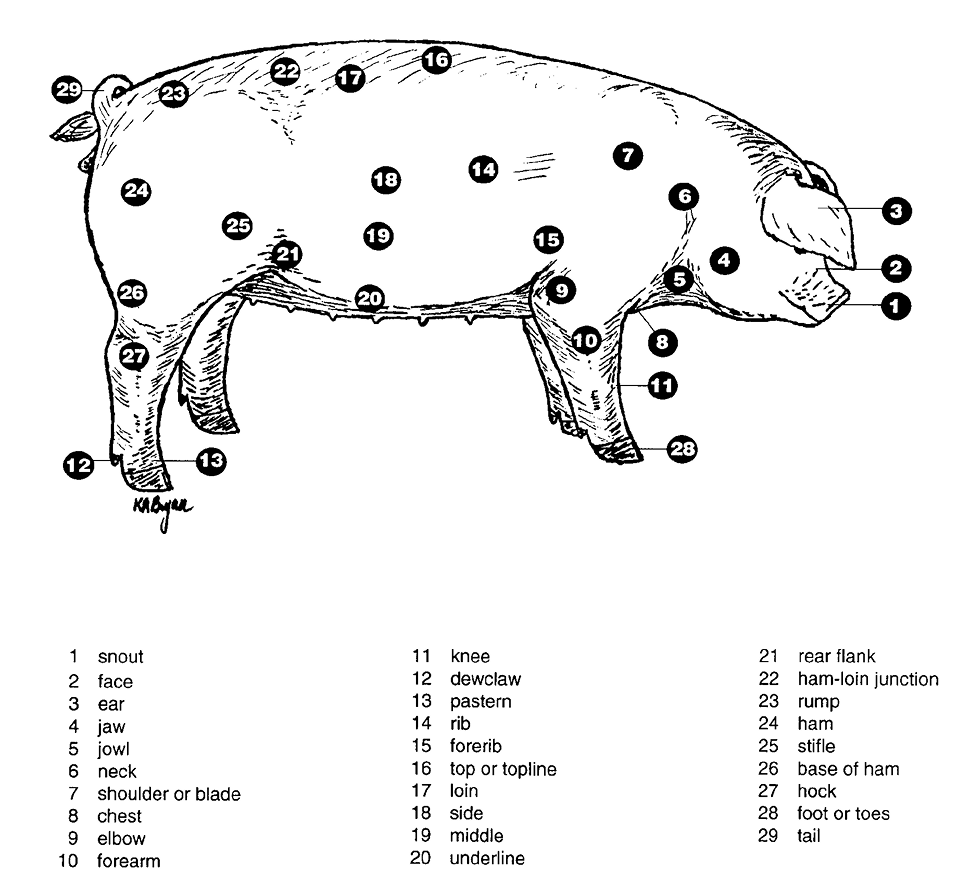
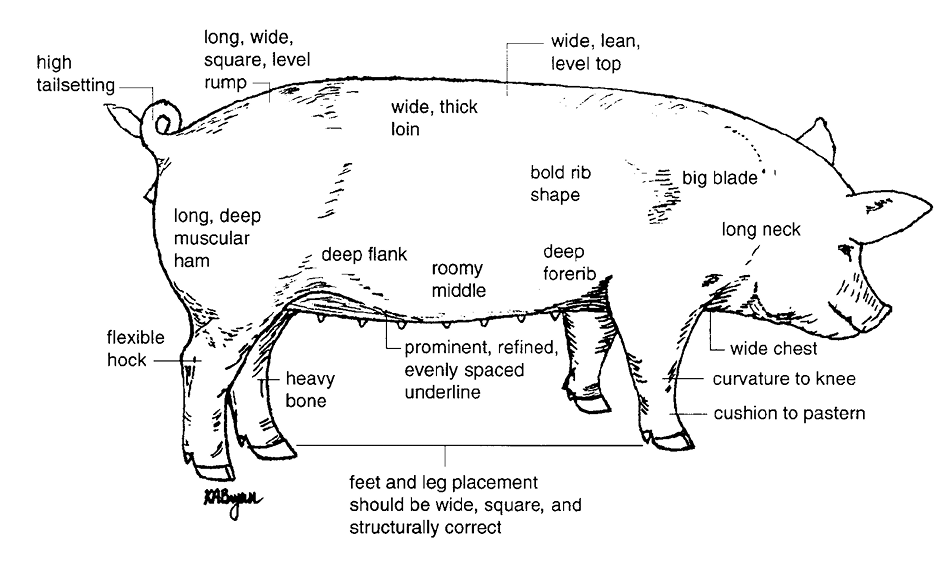
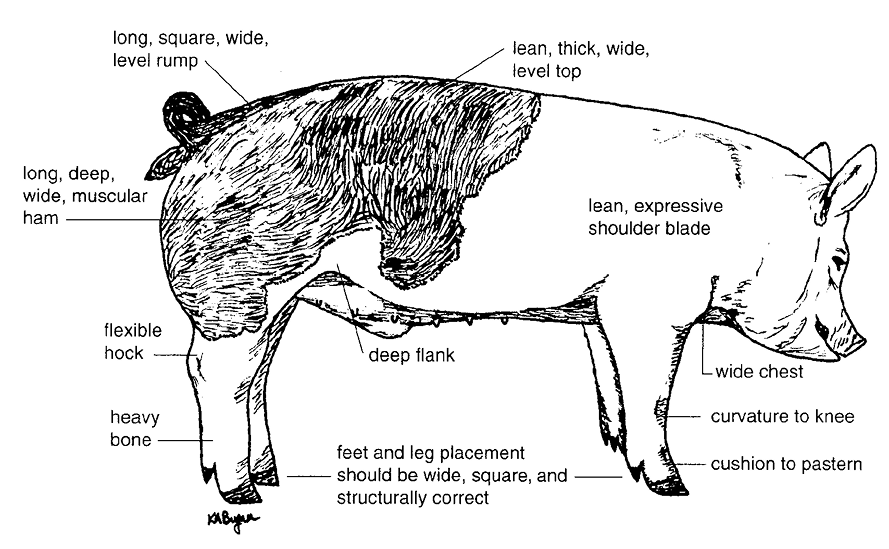
|
|
Normal range |
Average |
Ideal |
|---|---|---|---|
|
Live weight (lb) |
210-270 |
245.0 |
245.0 |
|
Dressing percent |
68-77 |
72.0 |
75.0 |
|
Average backfat (in) |
0.7-2.0 |
1.5 |
1.0 |
|
Carcass length (in) |
28-34 |
30.5 |
32.0 |
|
Loineye area (sq. in) |
3.0-7.0 |
4.5 |
5.8 |
|
Percent muscle |
45-65 |
51.0 |
54.0 |
Adapted from Live Animal Carcass Evaluation and Selection Manual, 4th edition, 1993, Donald L. Boggs and Robert A. Merkel.
Swine Terminology
General
More Desirable Characteristics
- growthier
- more performance oriented
- faster growing
- higher performing
- more functional
- more problem free
- more complete
- more fault free
- larger outlined
- larger scale
- longer sided
- nicer balanced
- more desirable composition of gain
Less Desirable Characteristics
- slower growing
- lower performing, poorer performing
- smaller outlined
- smaller scale
- shorter sided
- more off balance
- less desirable composition
Durability and Bone
More Desirable Characteristics
- more durable
- heavier boned
- stood on more substance of bone
- more ruggedly designed
- bolder fronted
- bolder sprung
- stood on greater substance of bone
- greater diameter of bone
Less Desirable Characteristics
- frailer
- finer boned
- stood on finer bone
- narrow fronted
- frailer
- finer boned
Structure and Movement
More Desirable Characteristics
- more confinement adaptable
- looser _______
- looser in (his/her) skeleton
- sounder
- sounder designed
- leveler topped
- leveler rump
- leveler in (his/her) rump design
- more curvature to (his/her) knee
- more even in (his/her) toe length
- more desirable slope to (his/her) shoulder
- more flex of hock
- more animation to (his/her) hock
- more cushion to (his/her) pasterns
- looser strided
- freer strided
- longer strided
- more flexible
- wider tracking
- moves out with more ______
Less Desirable Characteristics
- less confinement adaptable
- tighter ________
- tighter in (his/her) skeleton
- poorer structured
- tighter structured
- higher topped
- steeper rump
- steeper in (his/her) rump design
- buck-kneed, straighter through (his/her) knee
- more uneven in (his/her) toe length
- straighter in (his/her) shoulder
- straighter in (his/her) hock
- posty legged
- straighter in (his/her) pasterns
- more tightly wound
- shorter strided
- more tightly wound
- narrower tracking
- moves out with less _____
Volume and Capacity
More Desirable Characteristics
- bigger volumed
- higher capacity
- roomier middled
- looser middled
- deeper chested
- deeper ribbed
- deeper sided
- deeper flanked
- looser flanked
- wider based
- wider through (his/her) lower one-third
- wider through (his/her) chest floor
- wider sprung
- bolder sprung
- more expanded in (his/her) chest floor
- more expanded in (his/her) forerib
- more natural width through (his/her) rib
- more internal capacity
Less Desirable Characteristics
- less capacious, tighter ribbed
- tighter middled
- shallower chested
- shallower ribbed
- shallower in (his/her) flank
- tighter in (his/her) flank
- narrower based
- narrower through (his/her) lower one-third
- narrower through (his/her) chest floor
- narrower chested
- pinched in (his/her) forerib
- constricted in (his/her) rib
- less capacious
Muscle
More Desirable Characteristics
- heavier muscled
- more expressively muscled
- more natural thickness _______
- more natural turn of top
- more desirable turn to (his/her) top
- pushes more stifle on the move
- wider and more expressively muscled from stifle to stifle
- wider and squarer rump
- thicker through (his/her) rump
Less Desirable Characteristics
- lighter muscled
- flatter in (his/her) muscle
- lacks muscle expression _________
- flatter in (his/her) stifle
- narrower through (his/her) rump
Condition
More Desirable Characteristics
- leaner turn to (his/her) top
- less condition over (his/her) loin edge
- leaner through (his/her) lower one-third
- cleaner topped
- leaner made
- leaner designed
- had a groove down (his/her) top
- had a dimple above (his/her) tail
Less Desirable Characteristics
- more condition over (his/her) loin edge
- wastier over (his/her) loin edge
- pushes more fat in (his/her) elbow pocket
- plainer down (his/her) top
- heavier conditioned
- has more fat _______
- plainer down (his/her) top
Market and Carcass
More Desirable Characteristics
- more producer oriented
- more packer oriented
- more packer acceptable
- more industry oriented
- required fewer days to 230
- took fewer days to reach 230
- should rail ________
- higher lean-to-fat ratio
- heavier muscled carcass
- carcass with the most edible lean
- carcass with a higher percentage muscle
- carcass with a higher percentage ham/loin
- carcass with a higher percentage lean cuts
- carcass with more loin muscle area
- more muscular turn to (his/her) top
- more muscle thickness deeper into the ham
- wider in the lower one-third of the ham
Less Desirable Characteristics
- less producer oriented
- less packer oriented
- less packer acceptable
- less industry oriented
- required more days to 230
- took a greater number of days to reach 230
- lighter muscled carcass
- carcass with the least edible lean
- carcass with a lower percentage muscle
- carcass with a lower percentage ham/loin
- carcass with a lower percentage lean cuts
- carcass with less loin muscle area
- narrower in the lower one-third of the ham
Femininity and Underline
More Desirable Characteristics
- more feminine fronted, as evidenced by _______
- longer in her neck
- longer fronted
- higher quality underline that was ______
- more functional underline
- more evenly spaced teats
- more refined teats
- more numerous
- more prominent underline
Less Desirable Characteristics
- shorter in her neck
- shorter fronted
- poorer quality underline that was _______
- blind teats
- uneven in her teat spacing
- thicker, coarser teats
- possessed a pin teat (where?)
- was blunt in her teats (where?)
- looser in her rear udder sections
Performance and Miscellaneous
More Desirable Characteristics
- more desirable EPDs across all traits
- more desirable _________ EPDs
Less Desirable Characteristics
- less desirable ________ EPDs
More Potential to Sire Pigs with _______
- width
- muscle
- growth
- leanness
- soundness
- confinement adaptability
Less Potential to Sire Pigs with _______
- width
- muscle
- growth
- leanness
- soundness
- confinement adaptability
Should Sire Pigs with more _______
- width
- muscle
- growth
- confinement adaptability
Performance Data for Swine
As with classes of beef cattle and sheep, inclusion of performance data with a class of swine challenges you to make complex decisions while using a variety of information. Not only must the physical characteristics of each animal be evaluated, but the appropriateness of the data for the given production situation must also be considered. A complete understanding of the following swine production terms will enable you to evaluate a class of swine more critically.
- Birth Date – Actual date an animal was born.
- Number Born Alive – The number of pigs in a litter that were born alive (actual, NBAEPD).
- Number Weaned – The number of pigs in a litter that were weaned. The standard weaning age for swine is 21 days (actual).
- Litter 21-Day Weight – Weight of an entire litter of pigs between 14 and 28 days of age and adjusted to a constant age of 21 days (actual, ratio, LW21EPD).
- Sow Productivity Index – Also referred to as SPI. The sow productivity index is an indicator of maternal ability, and it combines the number of pigs born alive and the 21-day litter weaning weight into an index (actual, ratio).
- Days to 230 Pounds – An indicator of growth rate, days to 230 is the number of days that a hog required to reach 230 pounds. A lower number is more desirable than a higher number (actual, DAYSEPD).
- Backfat Thickness – The depth of backfat listed either as average backfat thickness or 10th- rib fat depth. A lower number indicates that a hog is leaner than a hog with a higher number (actual, ratio, BFEPD).
Expected Progeny Differences (EPDs) for Swine
Much like sheep producers, swine producers have requested more objective selection tools for selecting replacement gilts and boars within and across herds. Expected progeny differences have been used in the beef cattle industry for some time and are now also being used in swine selection programs. These EPDs are very similar to those used by the beef cattle industry to predict progeny performance of animals.
Expected progeny differences for swine have been developed primarily for the economically important traits associated with swine production: an indication of maternal ability and of growth and carcass characteristics. The EPDs include the following:
Maternal EPDs
- Number Born Alive (NBA) – Daughters of sires or dams with a positive NBAEPD would farrow larger litters than sows with an NBAEPD of 0.
- Litter 21-Day Weight (LW21) – A positive LW21EPD indicates that daughters of sires or dams would produce litters heavier than average.
Growth and Carcass EPDs
- Days to 230 (DAYS) – A DAYSEPD of -3.00 indicates that progeny from this boar or gilt should reach 230 pounds 3 days sooner than progeny from an animal with a DAYSEPD of 0.
- Backfat Depth (BF) – An BFEPD of -.05 indicates that a boar should sire pigs having .05 inches less backfat than pigs from a boar with a BFEPD of 0.
Careful interpretation of EPDs for swine is necessary. Most producers want large litters of pigs that wean heavier, reach market weight sooner, and have less backfat. Therefore, NBAEPD and LW21EPD should be positive, indicating more pigs in the litter and heavier pigs at 21 days of age. Also, DAYSEPD and BFEPD should be negative, indicating fewer days required to reach 230 pounds and less backfat thickness at 230 pounds.
Selection indexes have been incorporated into the genetic evaluation of swine performance records. These selection indexes provide for consistent and accurate combining of various performance traits.
Selection Indexes
- Sow Productivity Index (SPI) – Ranks individuals on the number born alive (NBA) and litter 21-day weight (LW21). It does not include any growth or carcass information.
- Maternal Line Index (MLI) – This index uses growth and maternal EPDs, with emphasis on maternal EPDs for a maternal line.
- General Purpose Index (GPI) – Ranks animals on both growth and maternal traits. This index is well suited for use on maternal and paternal lines, as in a rotational crossbreeding system.
- Terminal Sire Index (TSI) – Ranks individuals on days to 230 (DAYS) and backfat depth (BF) only. This index does not include any maternal information.
All four indexes are listed in a manner similar to that for ratios (average = 100), with superior parents having values greater than 100 and inferior parents having values less than 100. These selection indexes have been developed based on the economic values associated with costs of production. Therefore, each index is listed in dollar units. For example, consider that a sow’s SPI is 106; then each of her daughters would be expected to produce litters worth $6 more at 21 days of age than the daughters of a sow with an SPI of 100.
Production Situations for Swine
Production situations for swine classes with performance data take on slightly different formats than for classes of beef cattle or sheep. In the scenarios for swine, a complete description of the following important factors must be addressed:
Breeding Program
- What type of breeding program is being used?
- How are the selected animals to be used in that program?
Marketing Program
- How are the hogs marketed?
- For what type of buyer are the hogs being produced?
Type of Environment
- In what type of environment are the hogs being raised?
- Examples: confinement, partial confinement, or nonconfinement.
The combination of a situation, performance data, and visual appraisal offers you the opportunity to make real-life animal-selection decisions.
Scenario 1
Hampshire Boars
Assume these Hampshire boars are to be used as terminal sires on Yorkshire x Landrace sows. You do not retain any gilts as replacements; therefore, all hogs are sold as market hogs. You generally sell market hogs on a carcass merit buying program, and all of your hogs are raised in confinement.
|
No. |
Birth Date |
Dam's SPI | Days to 230 |
Adj. 10th Rib Fat |
Loineye Area |
|---|---|---|---|---|---|
|
1 |
10/20 |
104 |
165 |
.81 |
5.95 |
|
2 |
10/24 |
101 |
165 |
.71 |
6.05 |
|
3 |
10/31 |
101 |
173 |
.67 |
5.70 |
|
4 |
11/2 |
100 |
157 |
.73 |
6.65 |
Scenario 2
Yorkshire Gilts
Rank these gilts as you would use them as replacements in a purebred Yorkshire herd. You profit mainly from the sale of performance-tested boars and gilts to commercial swine operations; however, you do sell a few boars as herd sires. All of your hogs and your customers’ hogs are raised in total confinement.
|
No. |
Birth Date |
NBA |
LW21 |
Days |
BF |
|---|---|---|---|---|---|
|
1 |
3/27 |
+0.25 |
+1.92 |
-1.22 |
-0.03 |
|
2 |
4/4 |
+0.32 |
+3.40 |
-2.18 |
-0.01 |
|
3 |
4/8 |
+0.15 |
+2.33 |
-0.94 |
+0.04 |
|
4 |
4/8 |
-0.05 |
-0.39 |
-2.05 |
+0.04 |
Scenario 3
Duroc Boars
Assume these boars are to be used in a three-breed rotational crossbreeding system (Duroc x Yorkshire x Hampshire). Before selling feeder pigs, a group of replacement gilts is selected to be retained for breeding purposes. All hogs are maintained in a partial confinement situation.
|
No. |
Birth Date |
NBA |
LW21 |
Days |
BF |
|---|---|---|---|---|---|
|
1 |
2/10 |
-0.11 |
-2.22 |
+1.24 |
+0.01 |
|
2 |
2/15 |
+0.05 |
+0.55 |
-2.15 |
-0.07 |
|
3 |
2/17 |
-0.07 |
-1.38 |
-0.85 |
-0.03 |
|
4 |
2/20 |
+0.08 |
+1.33 |
-3.42 |
-0.05 |
Scenario 1
Priorities: Select boars that will increase performance of growth and carcass traits. Growth and carcass traits are extremely important because all hogs are sold as market hogs. Soundness is a priority.
Scenario 2
Priorities: Balanced program in all areas. Select gilts that are strong in maternal, carcass, and growth traits. Soundness is a priority.
Scenario 3
Priorities: Select boars that are strong in maternal traits (NBAEPD and LW21EPD) and growth traits (DAYEPD). Backfat EPD is of no concern in this scenario.
Sample Oral Reasons for Swine
2-4-1-3
“My placing of the market hogs was 2-4-1-3. I started with 2, as she had the best combination of muscle volume, leanness, and capacity in this class. Ideally, I would have liked to see my class winner more correct structurally and freer moving. Even so, I used 2 over 4 in my top pair as he was more pulled apart at his blades and carried more width and expression of muscle down his top and into the center and lower portions of his ham. He was also a trimmer made barrow that showed more blade action on the move and pushed less fat into his elbow pocket; he should hang the carcass with the highest percent muscle in the class. I concede that 4, the blue-butt barrow, was a more structurally correct barrow that was leveler topped and freer moving.
In a closer middle pair, I placed 4 over 1, as 4 was a more producer-oriented and practical barrow. He was a bigger volumed barrow that had more width to his chest floor, had more dimension to his rib, and was more expanded through his lower one-third. He was a more structurally correct barrow, with more give and cushion to his knee and hock. I recognized 1 as being a trimmer made barrow, with less fat out over his loin edge, but he was a narrow-made barrow that was constricted in his chest floor, flatter ribbed, steeper out through his rump, and straighter on his front and rear underpinning.
Nevertheless, in my bottom pair, I placed 1 over 3, as 1 was a leaner made, more packer-acceptable barrow. He was a longer bodied barrow that showed more overall muscle expression and dimension down his top and through the base of his ham. He had less fat over his blades and should hang a carcass with more packer and consumer appeal. I grant that the black barrow was deeper flanked and looser made, but he was a short-bodied barrow whose combination of wide top and narrow base indicated he was the fattest barrow in the class. Thank you.”
3-4-2-1
“My placing of the performance Hampshire breeding gilts was 3-4-2-1. I started with 3, as she combined muscling, broodiness, and performance data to the highest degree. Ideally, I would have liked to see my class winner even longer fronted.
Realizing this in my initial decision, I still preferred 3 over 4, as 3 was the thickest hipped, heaviest muscled gilt that displayed the most volume of ham and had the most shape and dimension down her top, both visually and by the paper. More importantly, she was the boldest bladed, broodiest appearing gilt that had the most depth and spring to her fore and center rib, while possessing the highest dam’s SPI.
I will admit that 4 was a longer fronted gilt that was cleaner through her lower one-third.
In my middle comparison, it was 4 over 2, as 4 was a taller fronted, larger scaled gilt that was longer bodied and later maturing. She too was a nicer designed, more structurally correct female that was leveler topped and had a more correct slope to her shoulder.
I grant that 2 was another clean-headed, lean-designed gilt that scanned with a larger loineye.
With this in mind, it was 2 over 1 in my final decision, as 2 was a cleaner bladed gilt that was freer of fat through her lower body. She also had more lean muscle shape down her top both visually and by the scan data. In addition, she had a more distinct, higher quality underline, with a higher teat count.
There was no doubt that 1 was a bolder ribbed, sounder structured female that required fewer days to reach 230. However, this failed to compensate for the fact that she was the heaviest conditioned gilt with the poorest quality underline and the lowest in her dam’s SPI. Quite simply, she was the least scenario-suited gilt in this class. Thank you.”
Glossary
- Accuracy (Reasons) – In a livestock judging contest, the contestant’s ability to describe correctly the differences among animals in a class.
- Actual Data – The actual records of the individual. For example, an Angus bull calf might have a 600-pound weaning weight, a Dorset ewe might have a 90-pound weight at 90 days, or a Hampshire boar might have a loin-muscle area of 6.55 square inches.
- Adaptability – The ability of an animal to adapt to changes in the environment in which it lives.
- Age-Weight Categories (Sheep) – Specific ages at which an animal’s weight should be taken and recorded for evaluation of performance records and calculation of the appropriate FEPDs.
- Backfat Thickness (Swine) – The depth of backfat, listed as either average, last-rib backfat thickness, or 10th-rib fat depth. A lower number indicates a leaner hog; a higher number, a heavier hog.
- Barrow (Swine) – A castrated male; a castrated boar pig.
- Birth Date – The date an animal was born.
- Birth Weight – The weight of an animal at birth. Heavy birth weights are associated with calving problems in beef cattle, lambing problems in sheep, and farrowing problems in swine. Heavier weights are usually associated with greater survival rates.
- Boar (Swine) – An intact male; a male that is not castrated; a male capable of breeding females.
- Bovine (Beef Cattle) – Scientific name for domestic beef cattle.
- Breed Character – Particular characteristics of separate breeds (such as color, horns, ear set, and wool type) that distinguish animals among the various breeds.
- Breed Class – Any set of categories that classifies breeds according to appearance or function.
- Breeding Animal – An animal kept for the purpose of breeding, as opposed to a market animal.
- Bull (Beef Cattle) – An intact male; a male that is not castrated; a male capable of breeding females.
- Calf (Beef Cattle) – A bovine that is younger than 1 year of age.
- Calving Ease (Beef Cattle) – The ability of a heifer, or cow, to deliver a calf without difficulty.
- Carcass – The muscle, bone, and fat associated with the slaughter of an animal after removal of the head, hide, and viscera (internal organs).
- Carcass Length (Swine) – The linear measurement from the anterior of the first rib to the anterior of the aitch bone (hipbone).
- Carcass Quality – The observed properties of a carcass that may directly or indirectly influence the palatability characteristics of the edible lean meat.
- Completeness (Reasons) – In a livestock judging contest, the contestant’s ability to describe thoroughly the differences among animals in a class.
- Conformation – The overall composition or appearance of an animal or a carcass.
- Cow (Beef Cattle) – A female that has had a calf.
- Cutability – The percentage of boneless, closely trimmed retail cuts of a carcass.
- Dam – The female parent of an animal.
- Days to 230 (Swine) – An indicator of growth rate, days to 230 is the number of days that a hog required to reach 230 pounds. A lower number is more desirable than a higher number.
- Delivery (Reasons) – The manner with which a livestock judging contestant presents his or her reasons.
- Distance (Reasons) – How far a livestock judging contestant stands from the judge. Depending on voice and stature, the distance varies. A distance of 6 to 10 feet is generally adequate.
- Dressing Percent – The proportion of carcass weight to live weight of an animal; carcass weight divided by live weight.
- Early Maturing – An animal or breed that typically reaches puberty and the ability to reproduce at an earlier age than other animals of that breed or species.
- Ewe (Sheep) – A female sheep of any age.
- Expected Progeny Difference – An Expected Progeny Difference (EPD) takes into account the relationships in a pedigree and predicts how progeny or offspring of a particular animal should perform relative to animals from an average parent.
- Eye Contact (Reasons) – The livestock judging contestant should look at the person that is listening to his/her reasons. If eye contact is maintained throughout the entire set, his/her delivery will be more professional.
- Fat Depth 10th-Rib (Swine) – The linear measurement of fat taken at the 10th rib and at a position that is three-fourths of the length of the loineye.
- Fat Thickness (Sheep, Beef Cattle) – The typical linear measurement of fat taken over the ribeye.
- Feed Efficiency – The calculated measurement of conversion of feed to body weight gain; pounds of feed divided by pounds of body weight gain.
- Fertility – The associated characteristics of reproduction.
- Fleece (Sheep) – The coat of wool covering a sheep.
- Fleece Clean Weight (Sheep) – The weight, in pounds, of a fleece that has been washed appropriately.
- Fleece Grade (Sheep) – The classification system used to describe grease wool. Three systems are used: the blood, or American, system; the numerical, or English, system; and the metric system.
- Fleece Grease Weight (Sheep) – The weight, in pounds, of a freshly shorn fleece that has not been washed or scoured.
- Fleece Staple Length (Sheep) – The length, in inches, of a lock of shorn wool.
- Fleece Type (Sheep) – A classification system to group sheep according to wool quality. Fleece type or wool type is considered as either fine, medium, long, or crossbred and describes the type of wool fiber characteristic of the breed.
- Flock EPD (Sheep) – These EPDs are similar to those used by the beef cattle industry to predict progeny performance of the animal. The EPDs can be listed as such, or they may take the form of Flock Expected Progeny Differences (FEPD) for sheep; presently, they can be used only within a flock.
- Flow (Reasons) – The way words are put together into phrases, sentences, and paragraphs is considered flow. A smooth flowing set of reasons is desirable.
- Frame Score (Beef Cattle) – A numerical value associated with height at the hip, in inches, for a particular age.
- General Purpose Index (Swine) – Ranks hogs on growth and maternal traits and is well suited for use in a rotational crossbreeding system.
- Gilt (Swine) – A female that has not had a litter of pigs.
- Gregariousness (Sheep) – The characteristic of a group of sheep to remain in close proximity to one another; flocking instinct.
- Growth Rate – Typically, the pounds of body weight gained during a specified period of time (average daily gain).
- Hardiness – The ability of an animal to withstand the environment.
- Heifer (Beef Cattle) – A female that has not had a calf.
- Hip Height (Beef Cattle) – Height at the hip, in inches.
- Inflection (Reasons) – Voice inflection is one of the most important items in the delivery of oral reasons. Emphasis should be placed on the words that describe the important differences among animals and the important characteristics of each animal.
- KP Fat Percent (Sheep) – The amount of fat contained in the kidney and pelvis regions relative to the carcass weight.
- KPH Fat Percent (Beef Cattle) – The amount of fat contained in the kidney, pelvis, and heart regions relative to the carcass weight.
- Lamb (Sheep) – Any sheep younger than 1 year of age.
- Late Maturing – An animal or breed that typically reaches puberty late; the ability to reproduce at a later age than other animals of that breed or species.
- Leg Score (Sheep) – The subjective characteristic indicative of the total volume of muscle in the leg of a lamb. Muscle volume in the leg is reflective of total carcass muscle.
- Litter Size (Swine) – The number of pigs in a litter.
- Litter Weight 21 Days (Swine) – Weight of an entire litter of pigs between 14 and 28 days of age and adjusted to a constant age of 21 days.
- Loin Muscle Area (Swine) – The surface area of the Longissimus dorsi muscle at the 10th rib of a pork carcass.
- Market Animal – Any young animal intended for slaughter.
- Maternal – The dam or the dam’s side of the pedigree.
- Maternal Line Index (Swine) – Ranks hogs by growth traits and maternal traits, with emphasis on the maternal EPDs.
- Mature Cow Weight (Beef) – Average weight of a group of cows from 6 to 10 years of age.
- Milking Ability – The ability of a female to produce milk. Typically, larger quantities of milk result in heavier offspring at weaning.
- Number Born Alive (Swine) – The actual number of pigs in a litter that were born alive.
- Number Weaned (Swine) – The number of pigs in a litter that were weaned. The standard weaning age for swine is 21 days.
- Organization (Reasons) – The manner in which notes are assembled and reasons are presented to an official judge.
- Paternal – The sire or the sire’s side of the pedigree.
- Pedigree – A diagram of the sire, the dam, and the grandparents of an animal (similar to a family tree).
- Percent Muscle (Swine) – The amount of lean meat contained in the carcass of a pig relative to the carcass weight.
- Performance Data and Records – Objective numerical indexes of economically important traits associated with livestock production.
- Pigment (Beef Cattle) – The characteristic color found around the eyes of certain breeds of beef cattle.
- Polled (Beef Cattle) – Natural trait of not having horns nor the genetic ability to develop horns.
- Postweaning – After weaning.
- Preweaning – Before weaning.
- Presentation (Reasons) – The manner in which oral reasons are spoken to an official judge.
- Production Situation – A description of particular limitations or goals of a breeding program that provides guidance for selection decisions involving the use of performance records (sometimes called scenario).
- Progeny – All offspring from a particular parent animal.
- Prolificacy – The ability to reproduce in quantity.
- Puberty – The age at which an animal is capable of reproducing.
- Quality Grade – Those factors associated with palatability characteristics of the lean, edible portion of meat, including color, texture, firmness, marbling, and age.
- Ram (Sheep) – An intact male; a male that is not castrated; a male capable of breeding females.
- Ratio – To rank animals within the same herd or flock, a ratio is used generally. A ratio consists of a number, typically around 100, that compares each animal to the other animals in a particular group. Any number less than 100 indicates that the animal’s performance was inferior to or less desirable than the average of the group; any number greater than 100 indicates that the animal’s performance record was superior to or more desirable than the average of the group.
- Reasons – The verbal justification for placing animals in a certain order.
- Ribeye Area (Beef Cattle, Sheep) – The surface area of the Longissimus dorsi muscle between the 12th and 13th ribs of a beef or lamb carcass.
- Scrotal Circumference (Beef Cattle, Sheep) – The distance around the testicles in the scrotum of a bull or ram, in centimeters, usually adjusted to 365 days of age. A greater scrotal circumference indicates that a male should have the capacity to produce greater volumes of semen, and his progeny should reach puberty at earlier ages.
- Sire – The male parent of an animal.
- Sow (Swine) – A female that has had a litter of pigs.
- Sow Productivity Index (Swine) – Also referred to as SPI. Sow productivity index is an indicator of maternal ability and combines the number of pigs born alive and the 21-day litter weaning weight into an index.
- Stance (Reasons) – The way a judging contestant stands when giving reasons. When the contestant gives a set of reasons, the situation should be as comfortable as possible for the judge and for the contestant.
- Steer (Beef Cattle) – A castrated male; a castrated bull.
- Terminal Sire – A breeding male that is used for generating market animals; it typically has a high growth rate and desirable carcass characteristics.
- Terminal Sire Index (Swine) – Ranks hogs on DAYSEPD and BFEPD only and does not include any maternal information.
- Terminology (Reasons) – The words and phrases used to describe differences among animals.
- Type of Birth (Sheep) – The number of lambs born to a ewe. The following designations are used: S-single, TW-twin, TR-triplet, and Q-quadruplet.
- Type of Rearing (Sheep) – The number of lambs raised by a ewe. The following designations are used: S-single, TW-twin, TR-triplet, and Q-quadruplet.
- Underline (Swine) – The teats or nipples on the underside or belly of a pig.
- Volume (Reasons) – How loud a contestant talks when giving reasons. The volume used to deliver reasons depends on how the contestant normally speaks and the size of the room.
- Weaning – The time when young animals are removed from their mothers and are forced to give up their dam’s milk as a source of nutrients.
- Weaning Weight – The weight of an animal at weaning or at a standard weaning age. Adjusted weaning weight is calculated for one of the standard weaning ages listed, and the standard age is listed also. The weight of a calf taken from 160 to 250 days of age and then adjusted to a constant age of 205 days. Standard weaning ages for lambs are 45, 60, 90, and 120 days. The standard weaning age for swine is 21 days.
- Wether (Sheep) – A castrated male sheep; a castrated ram.
- Yearling – An animal that is more than 1 year of age, but not more than 2 years old.
- Yearling Weight – The weight of an animal taken after 330 days of age and adjusted to a constant age of 365 days.
- Yield Grade (Beef Cattle, Sheep) – The numerical designation (1-5) for the percentage of boneless, closely trimmed, retail cuts obtained from a carcass.
Publication 2289 (POD-02-20)
Distributed by Dean Jousan, PhD, Associate Extension Professor, Animal and Dairy Sciences. Written by Gale Chrestman, former Extension Associate, and Keith A. Bryan, PhD, Pennsylvania State University Dairy and Animal Science Instructor.
Gale Chrestman, Keith A. Bryan, and Lowry Sumrall provided photography for the publication. The authors greatly appreciate the efforts and support of Roy Higdon, Mike Howell, and Blair McKinley for reviewing this publication. Donald L. Boggs and Robert A. Merkel are acknowledged for giving their permission to use material adapted from Live Animal Carcass Evaluation and Selection Manual, 4th edition, 1993. Gary L. Minish and Danny G. Fox are acknowledged for giving their permission to use material adapted from Beef Production and Management, 2nd edition, 1979.
Copyright 2020 by Mississippi State University. All rights reserved. This publication may be copied and distributed without alteration for nonprofit educational purposes provided that credit is given to the Mississippi State University Extension Service.
Produced by Agricultural Communications.
Mississippi State University is an equal opportunity institution. Discrimination in university employment, programs, or activities based on race, color, ethnicity, sex, pregnancy, religion, national origin, disability, age, sexual orientation, genetic information, status as a U.S. veteran, or any other status protected by applicable law is prohibited. Questions about equal opportunity programs or compliance should be directed to the Office of Compliance and Integrity, 56 Morgan Avenue, P.O. 6044, Mississippi State, MS 39762, (662) 325-5839.
Extension Service of Mississippi State University, cooperating with U.S. Department of Agriculture. Published in furtherance of Acts of Congress, May 8 and June 30, 1914. GARY B. JACKSON, Director
The Mississippi State University Extension Service is working to ensure all web content is accessible to all users. If you need assistance accessing any of our content, please email the webteam or call 662-325-2262.

